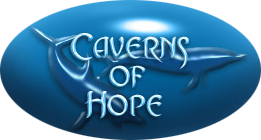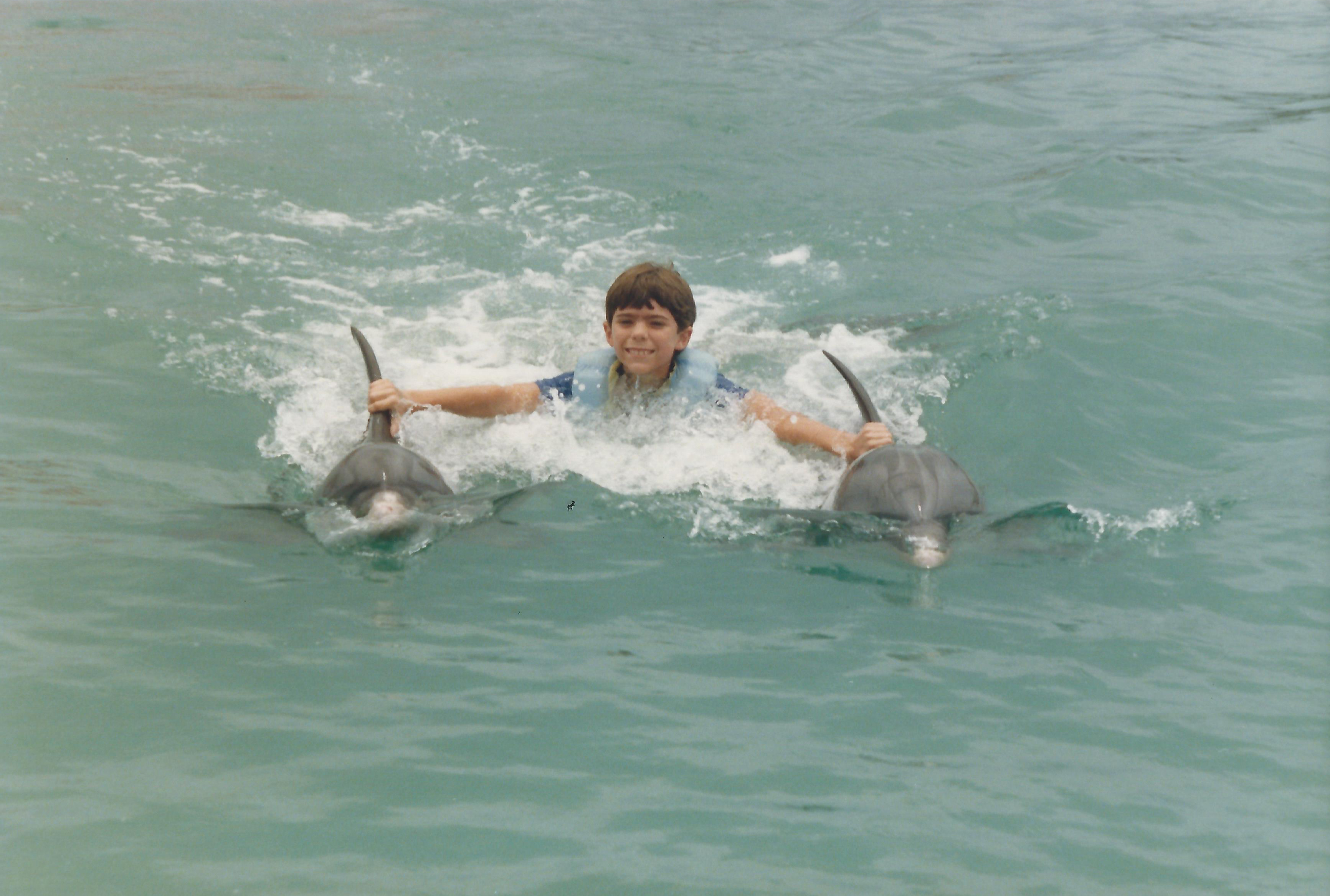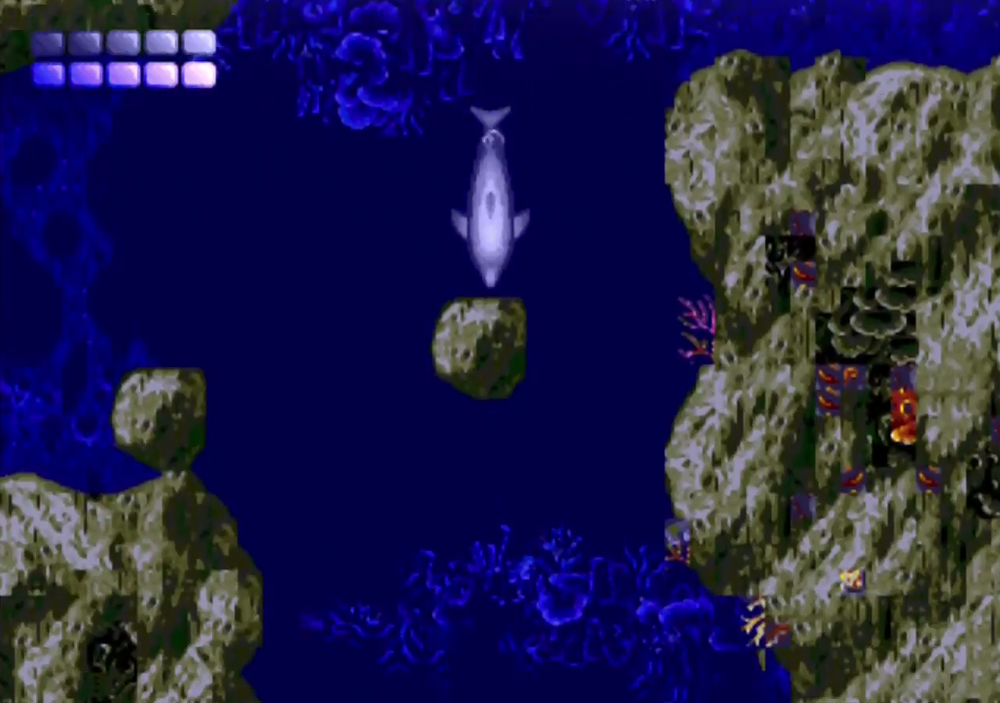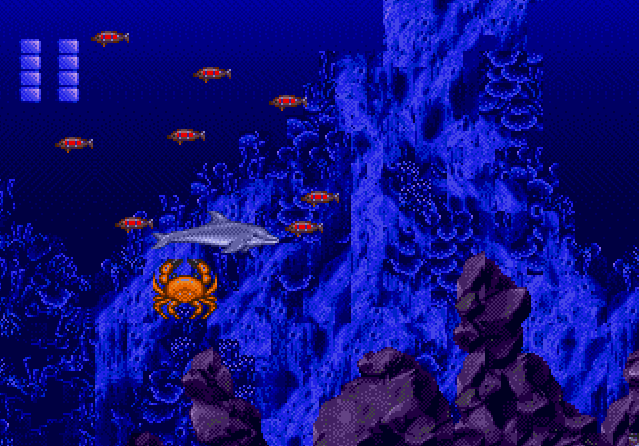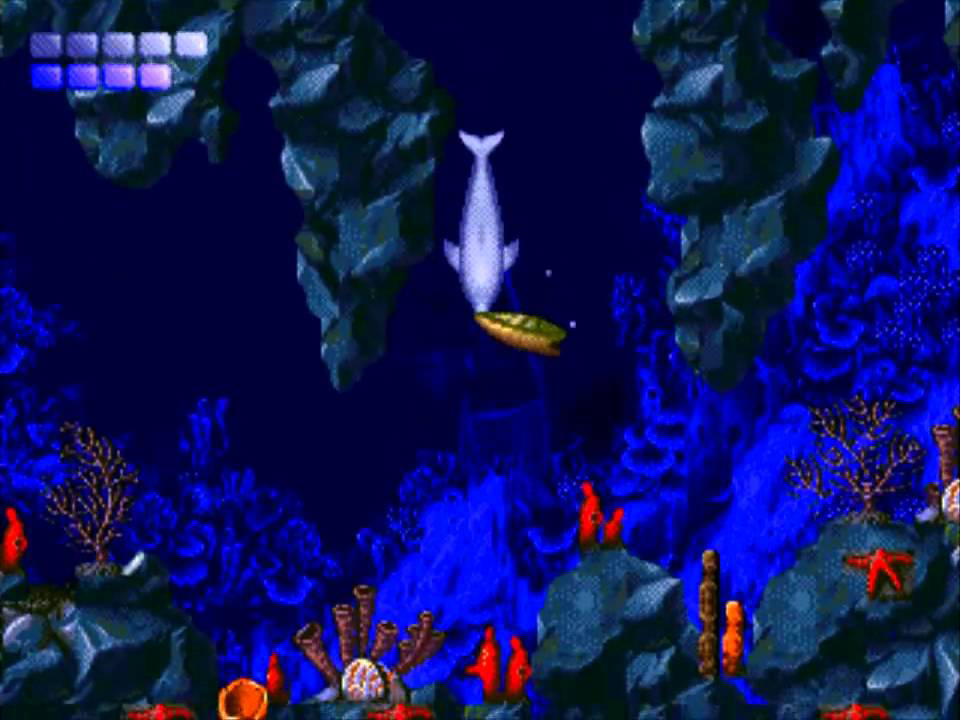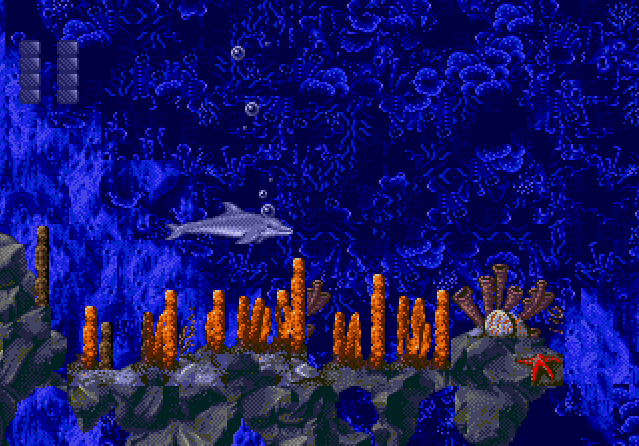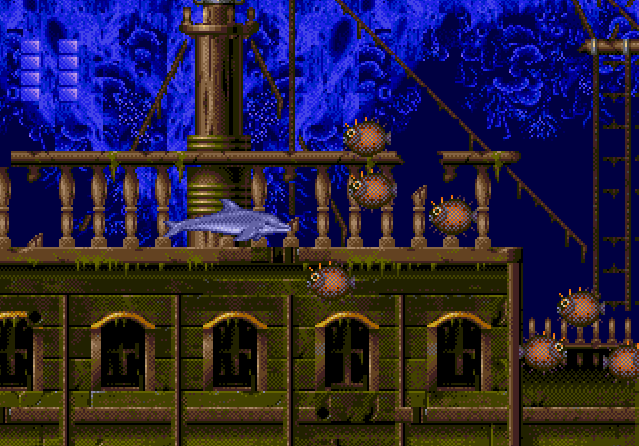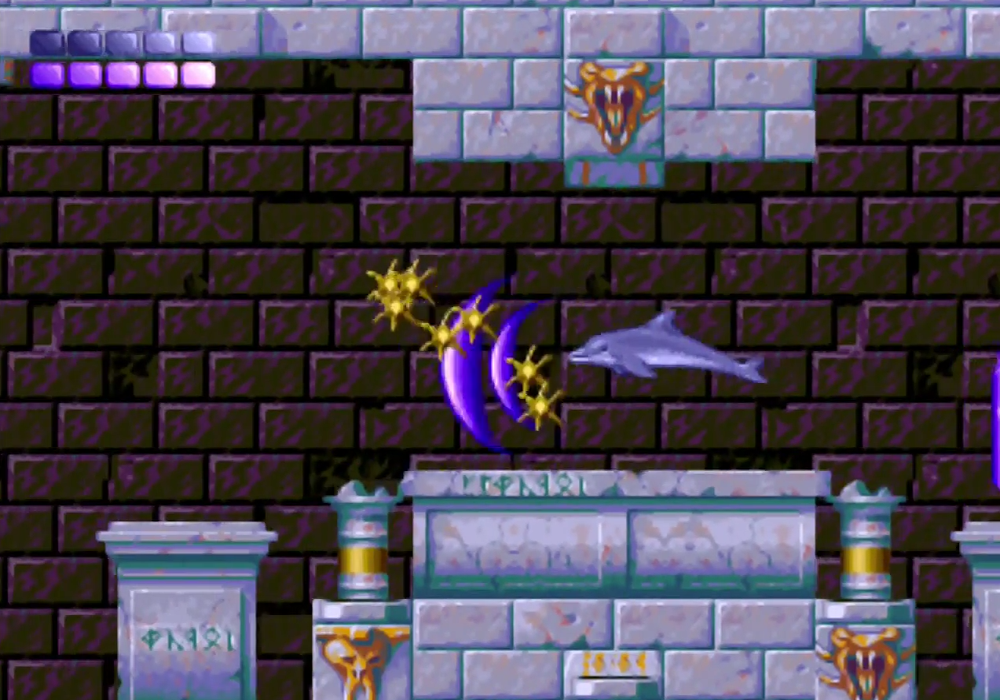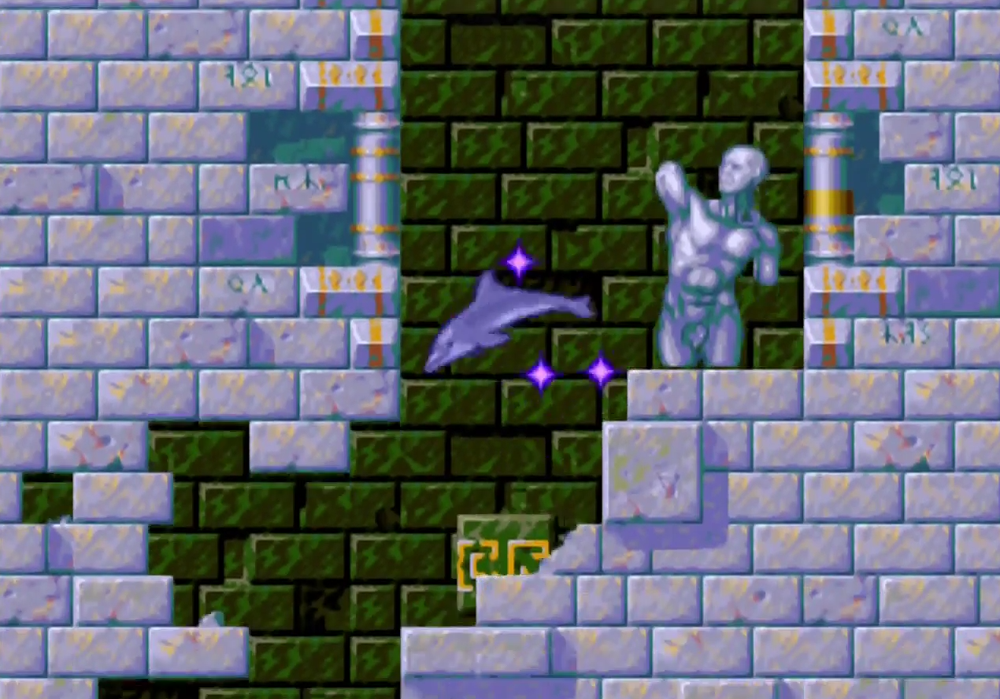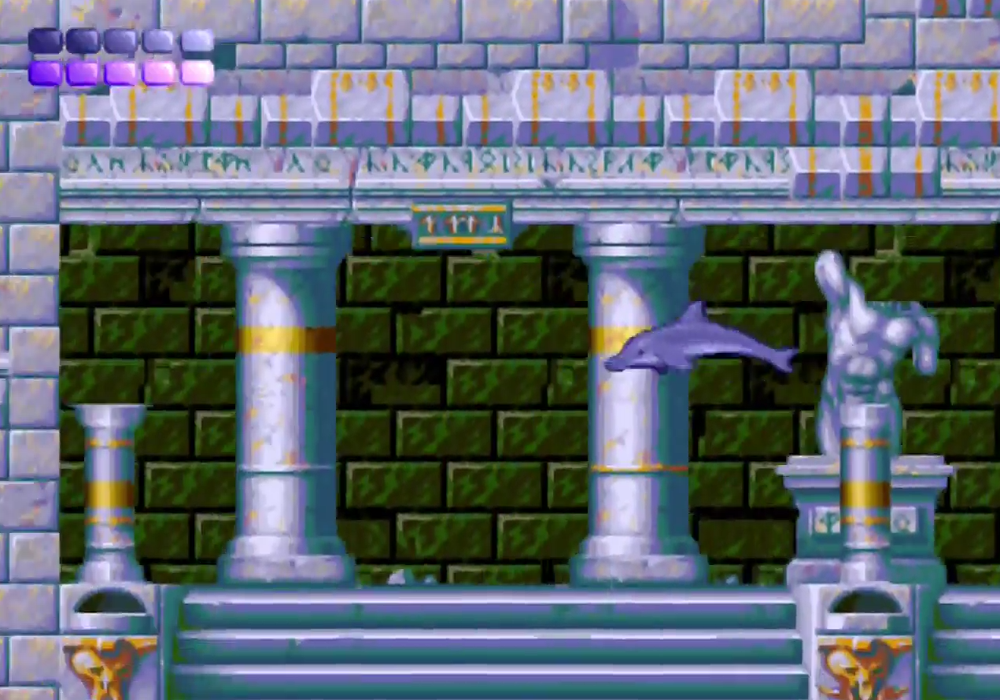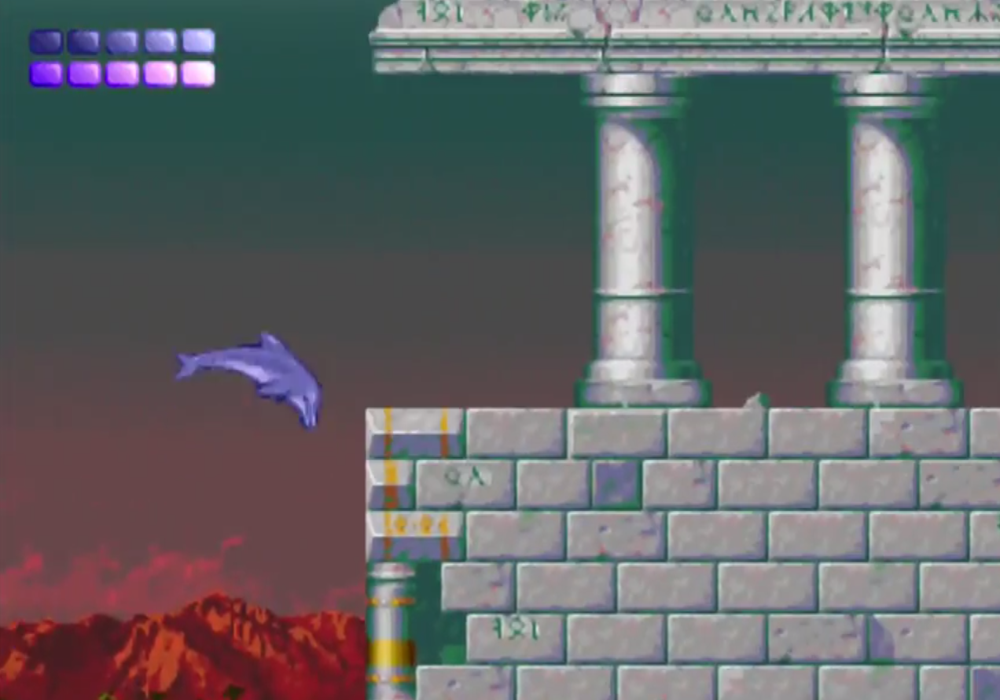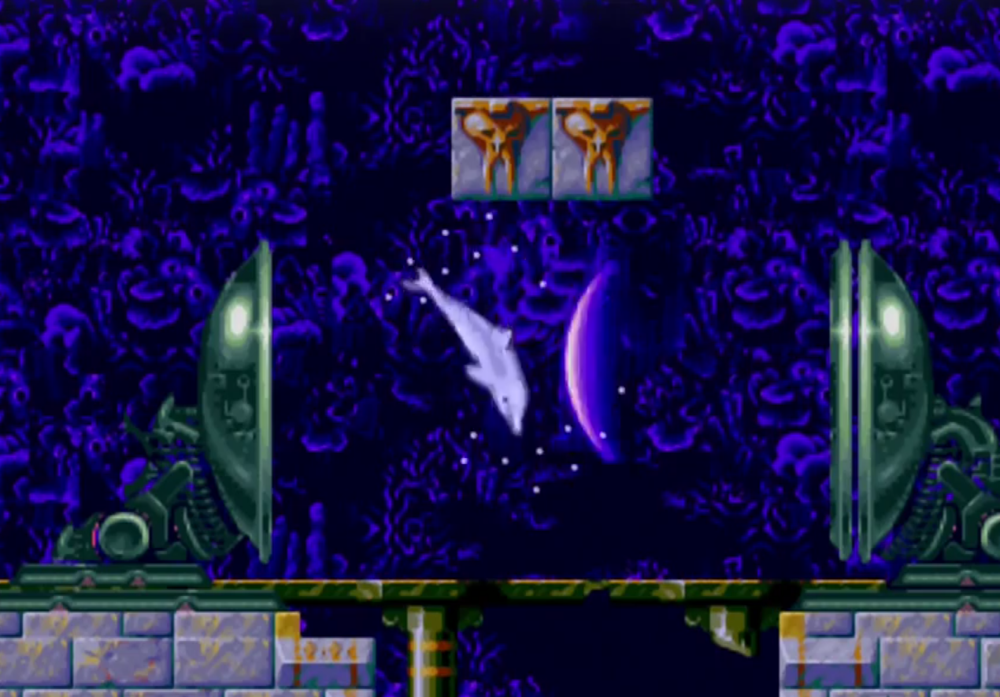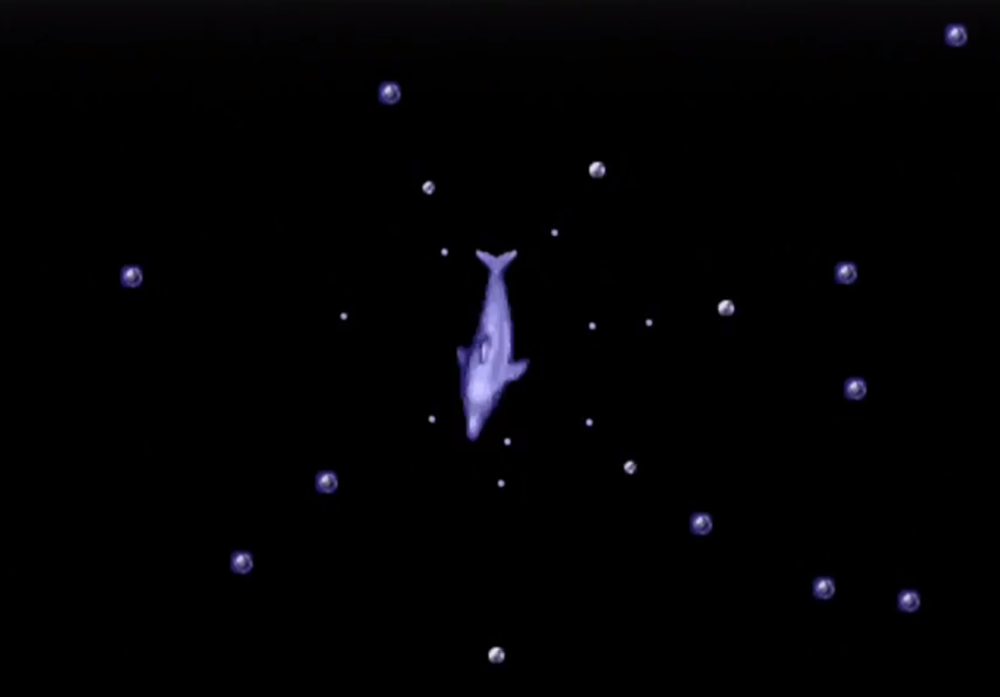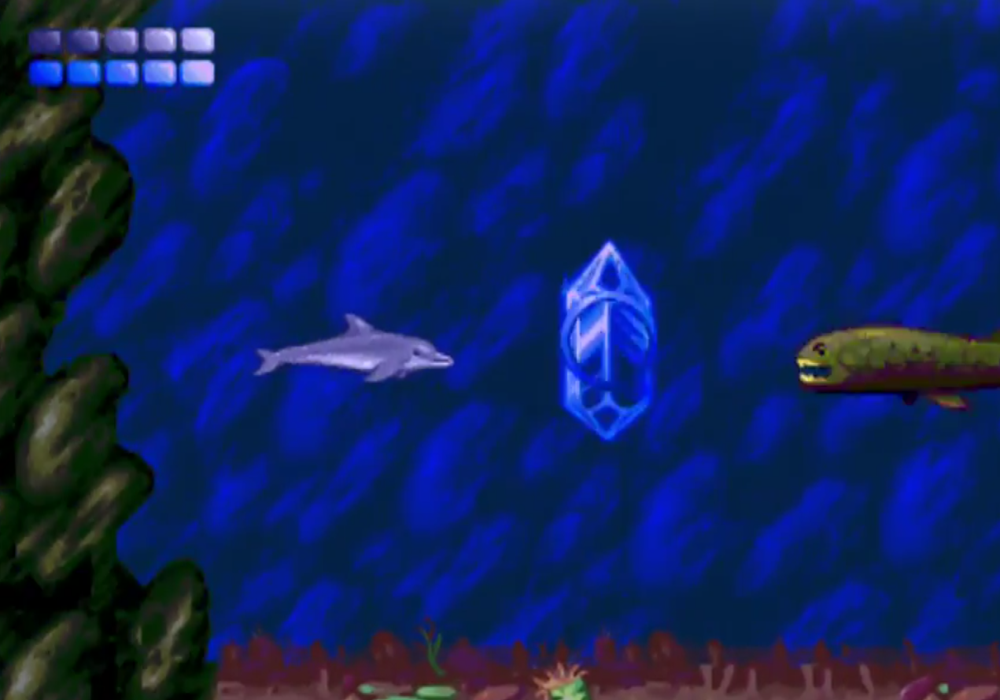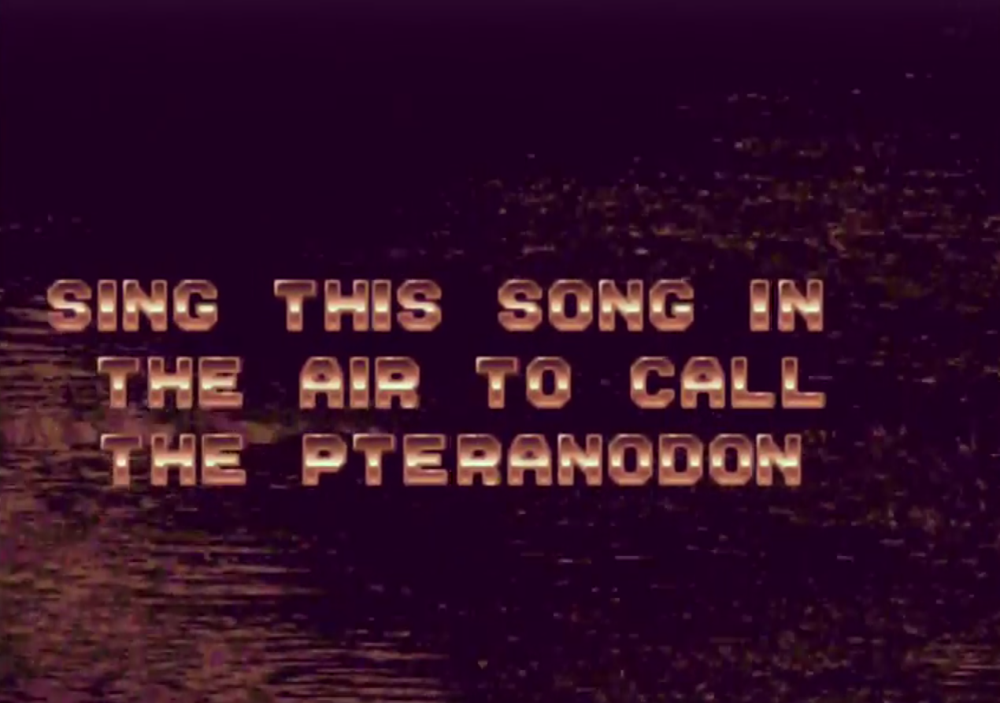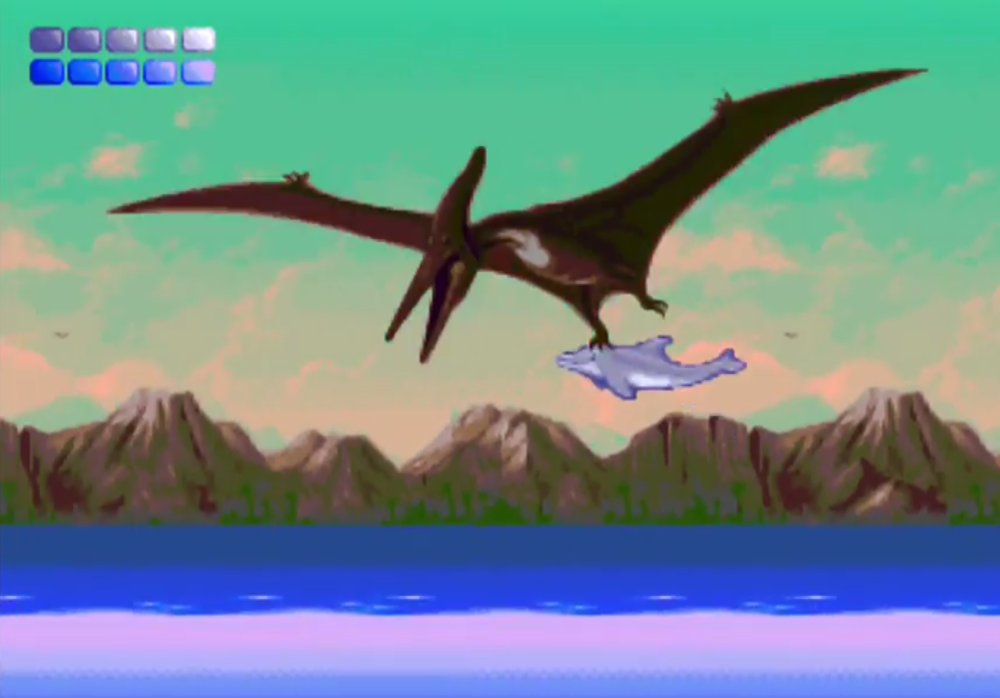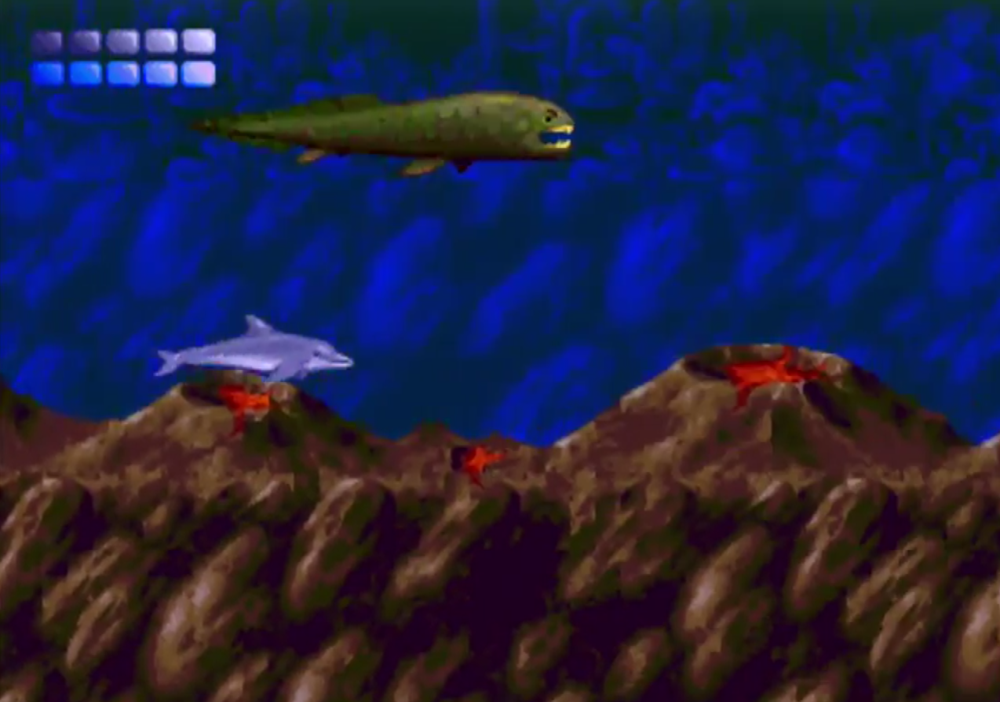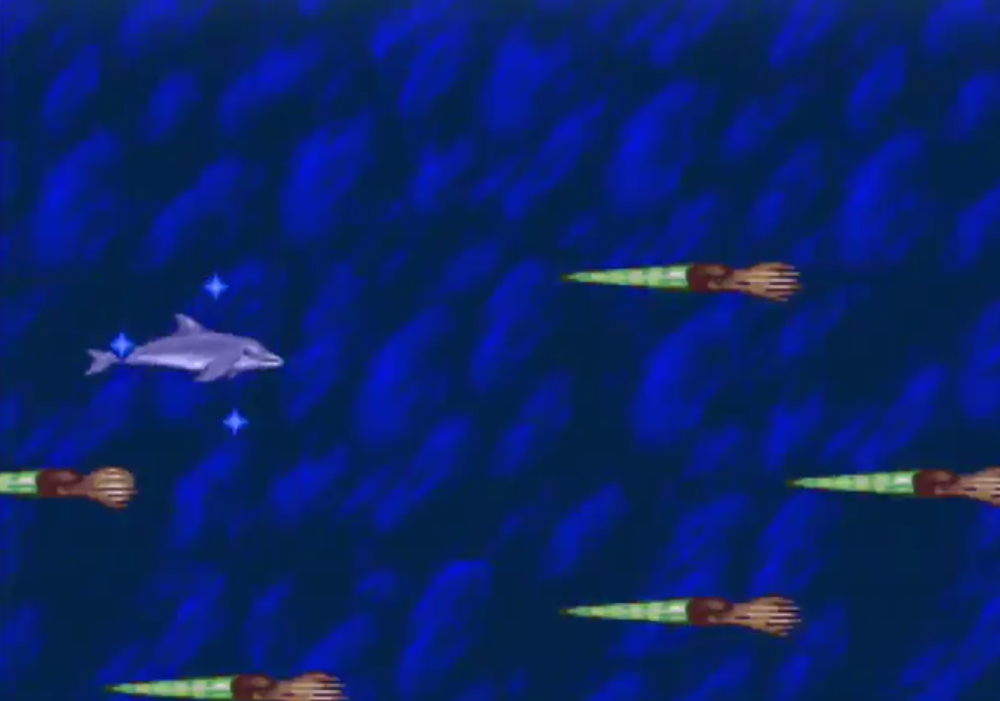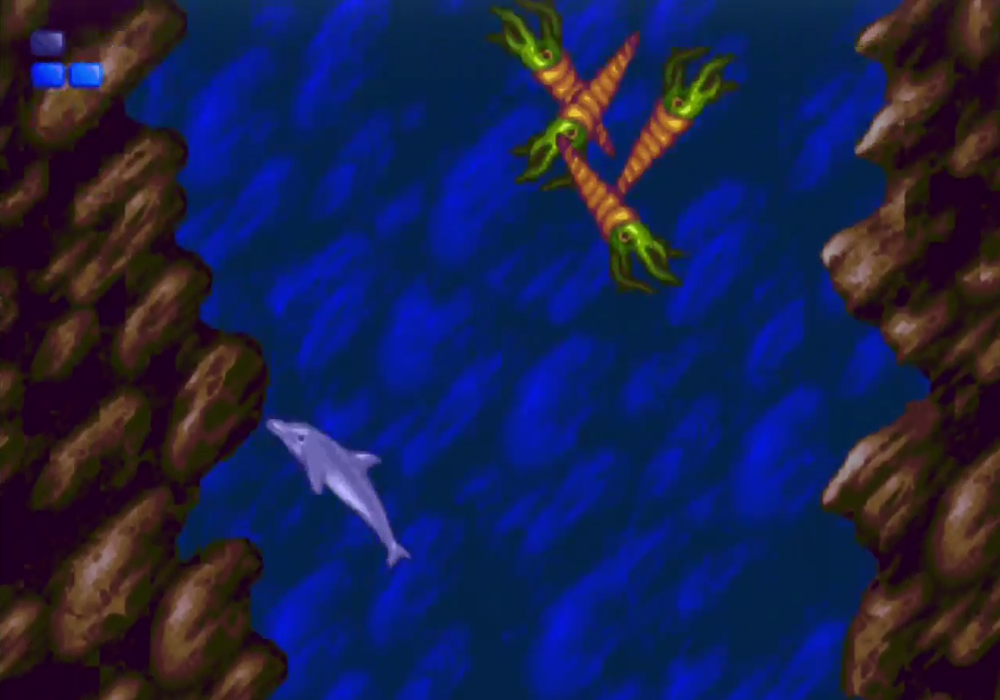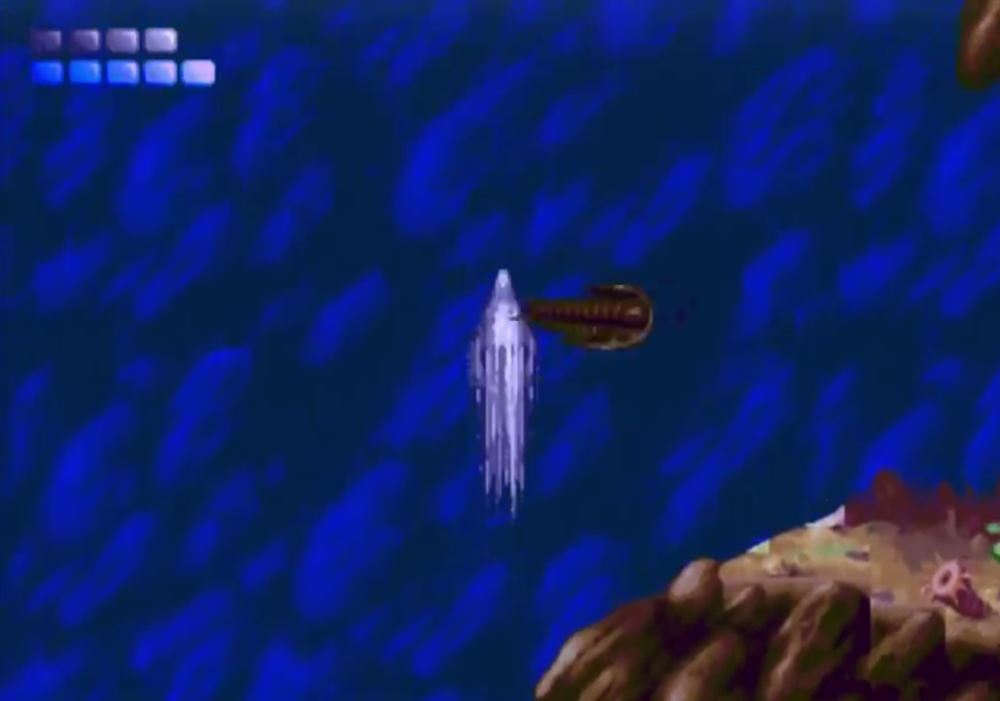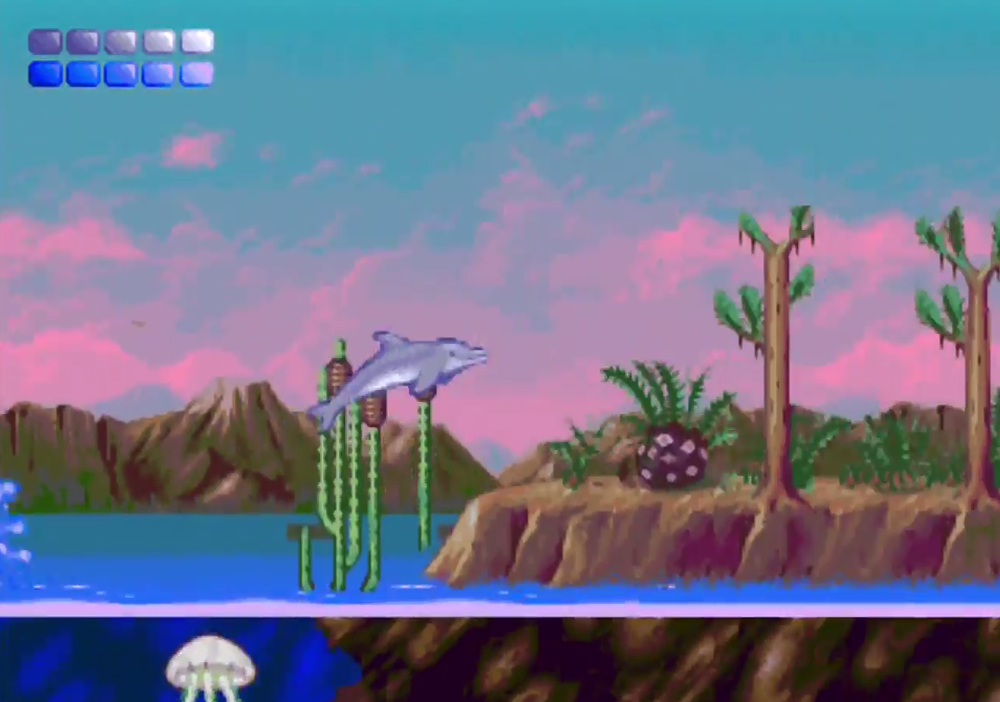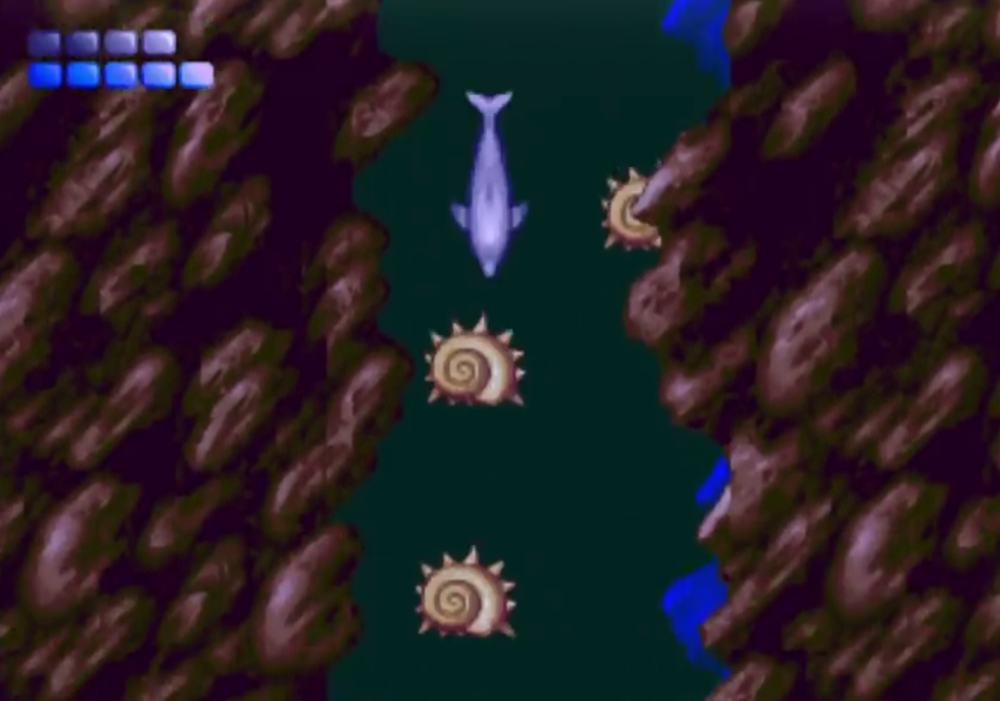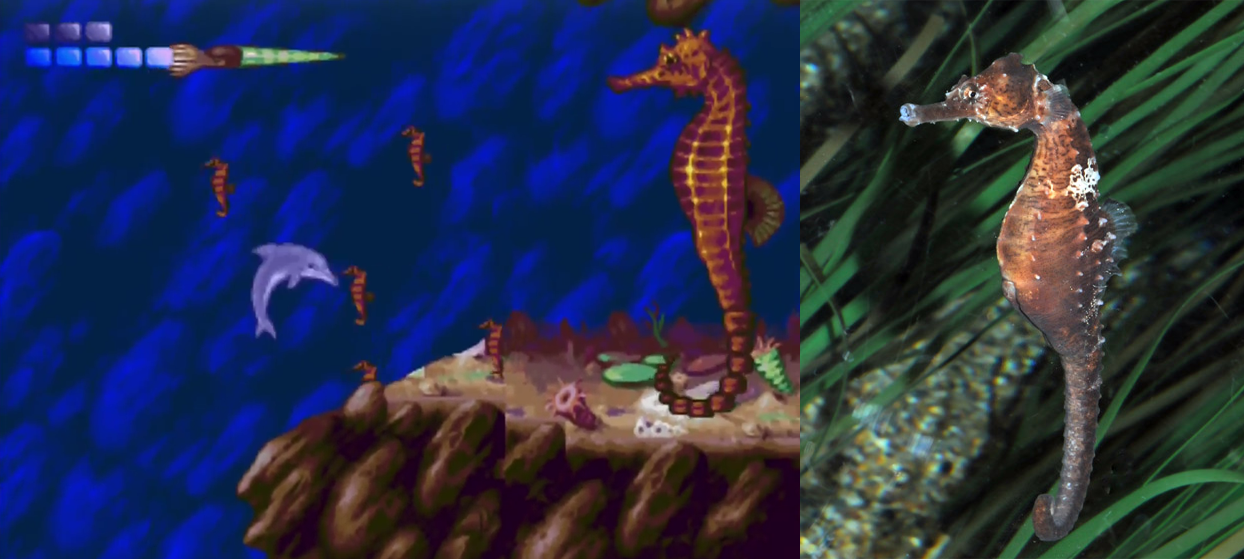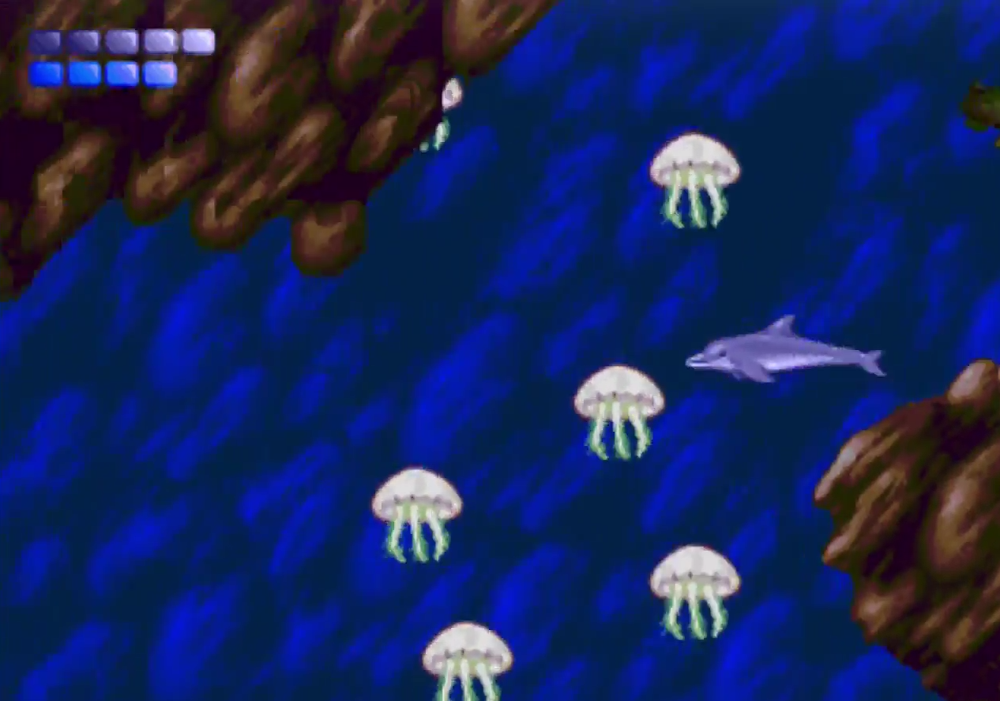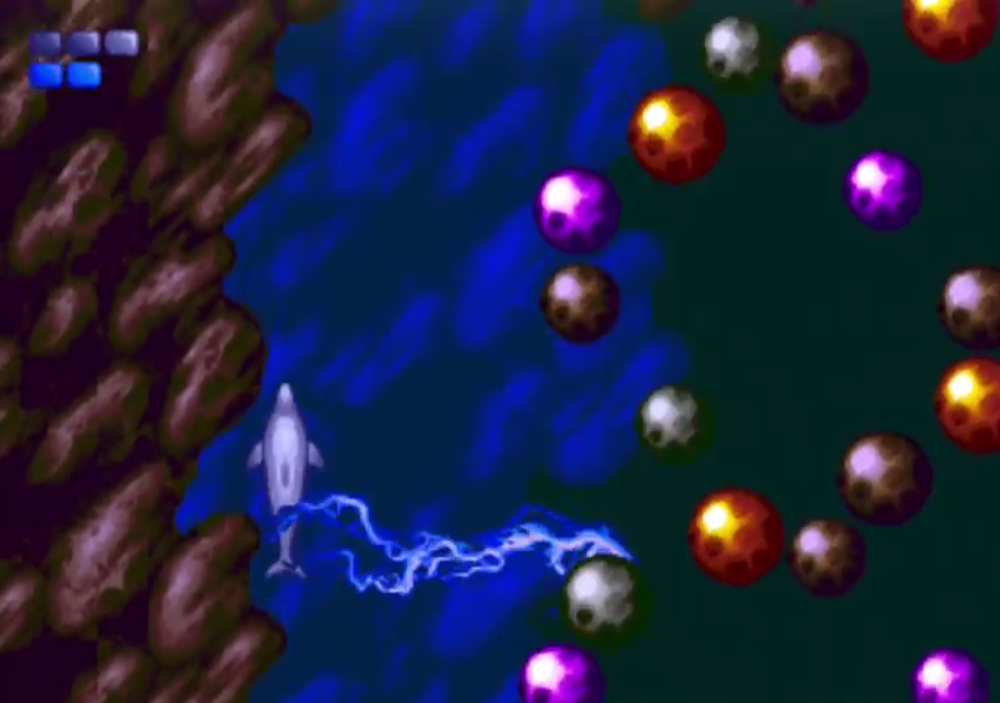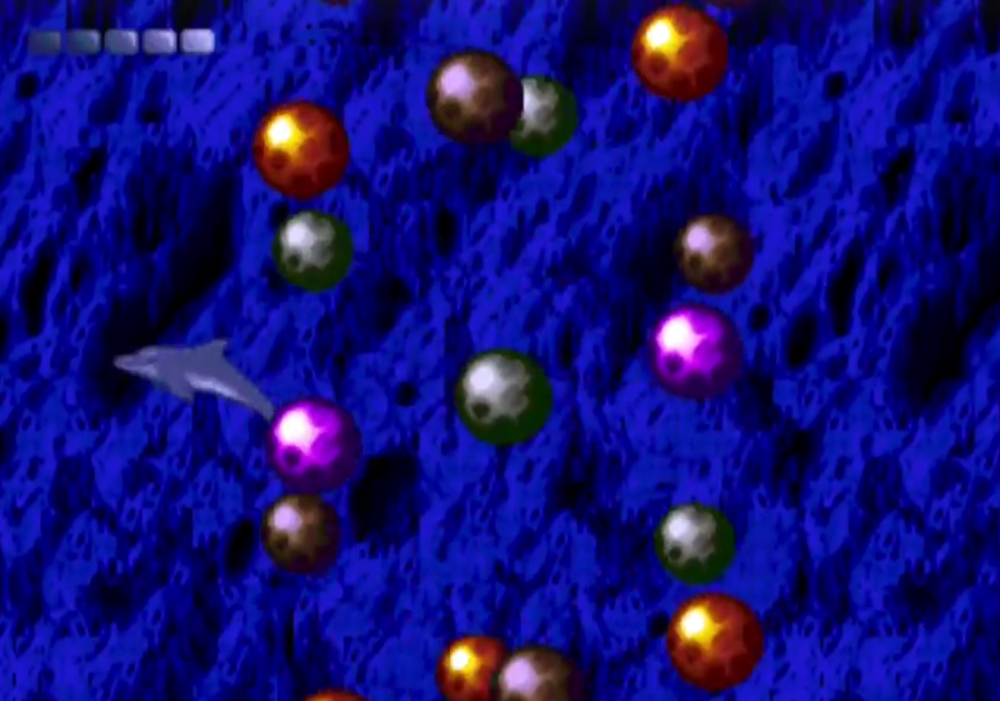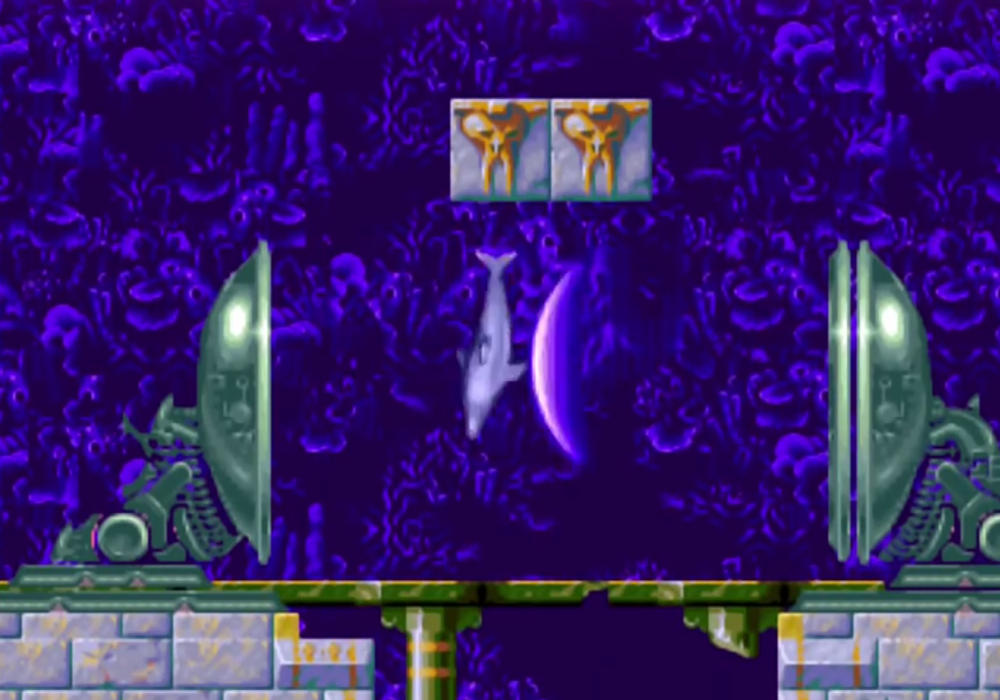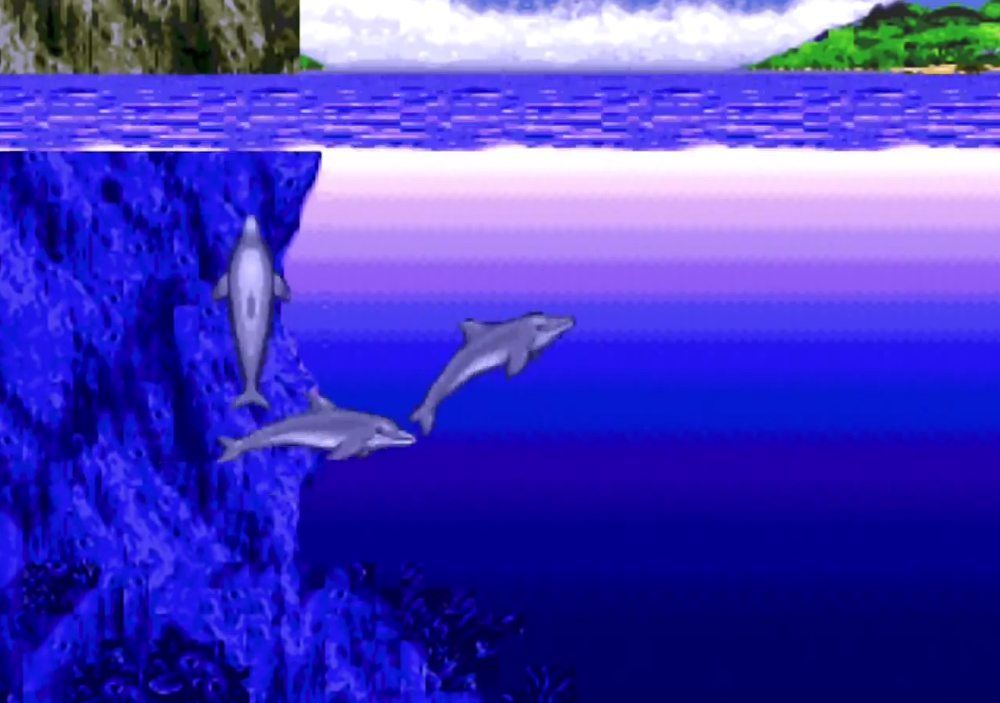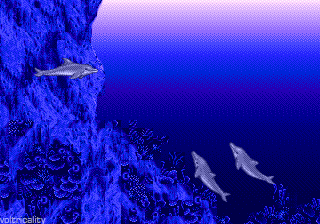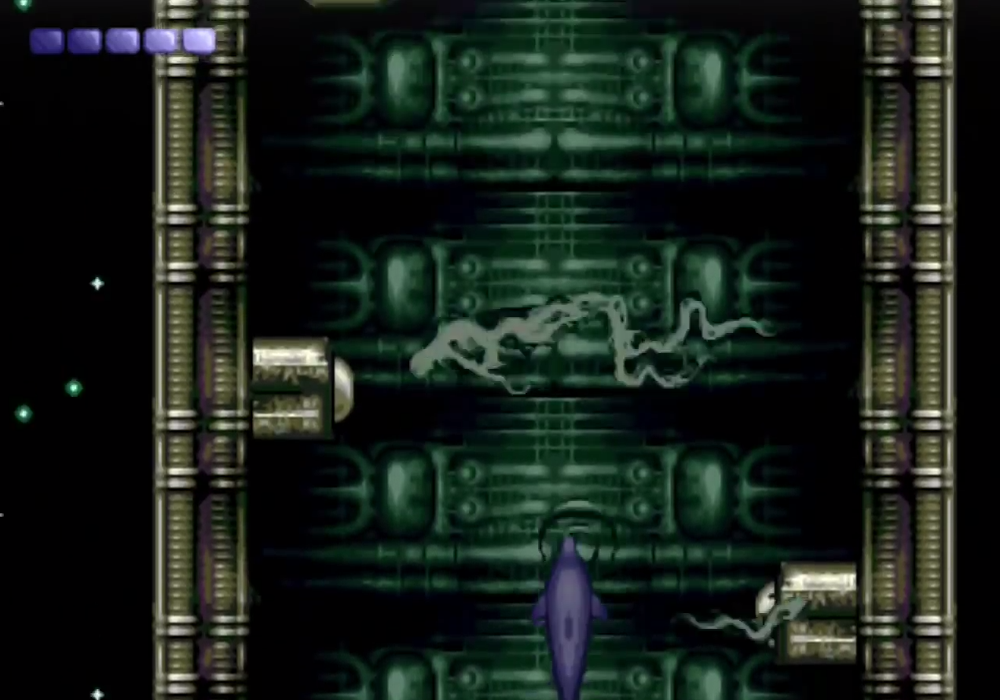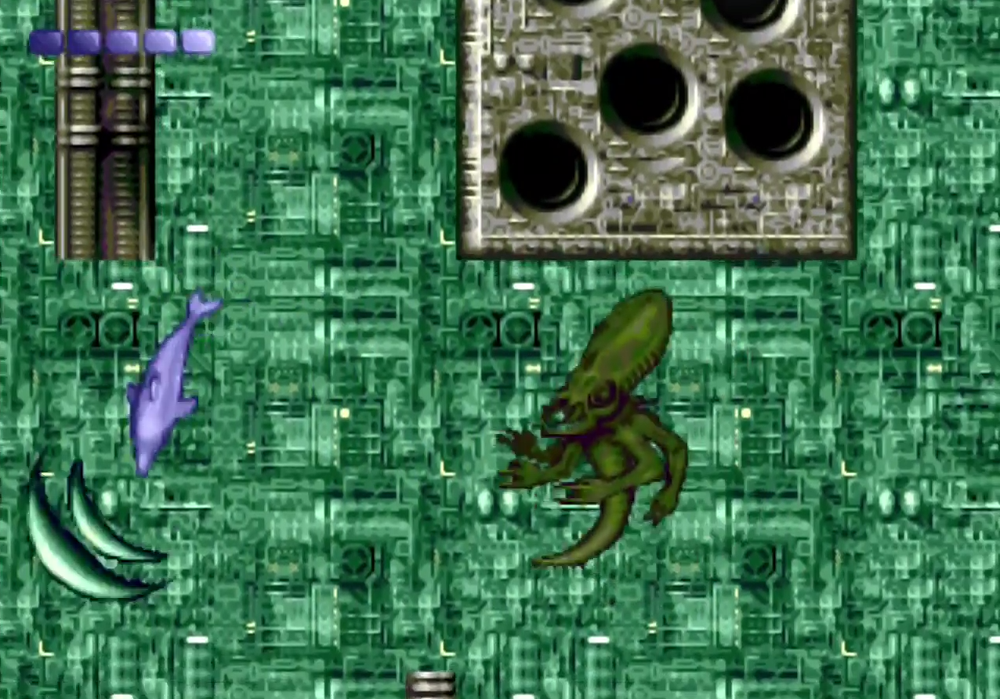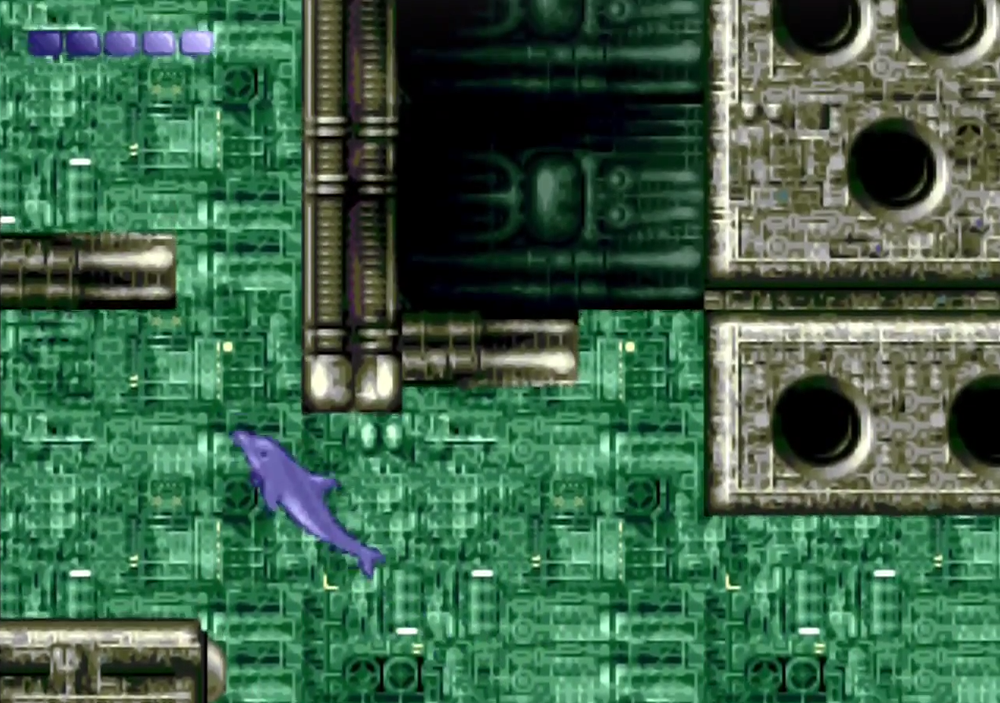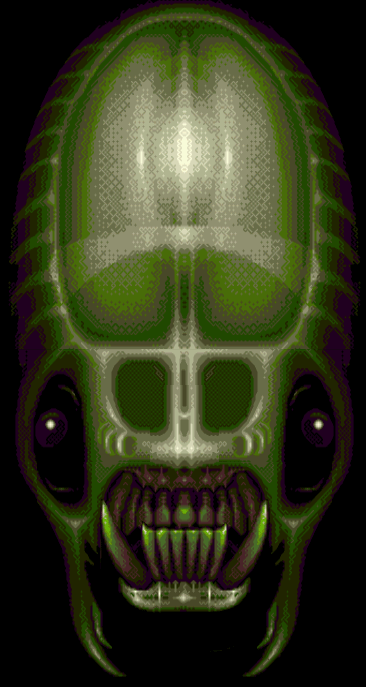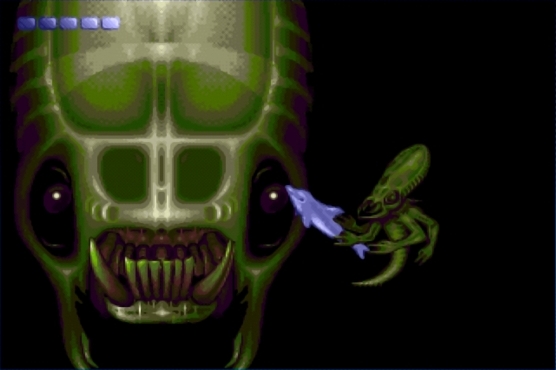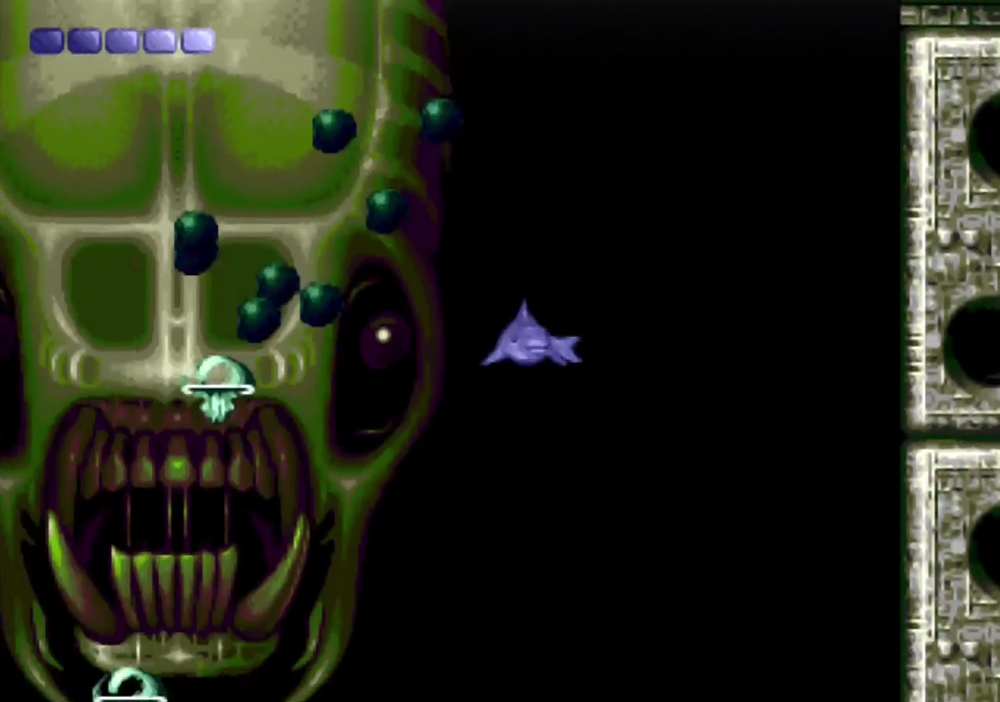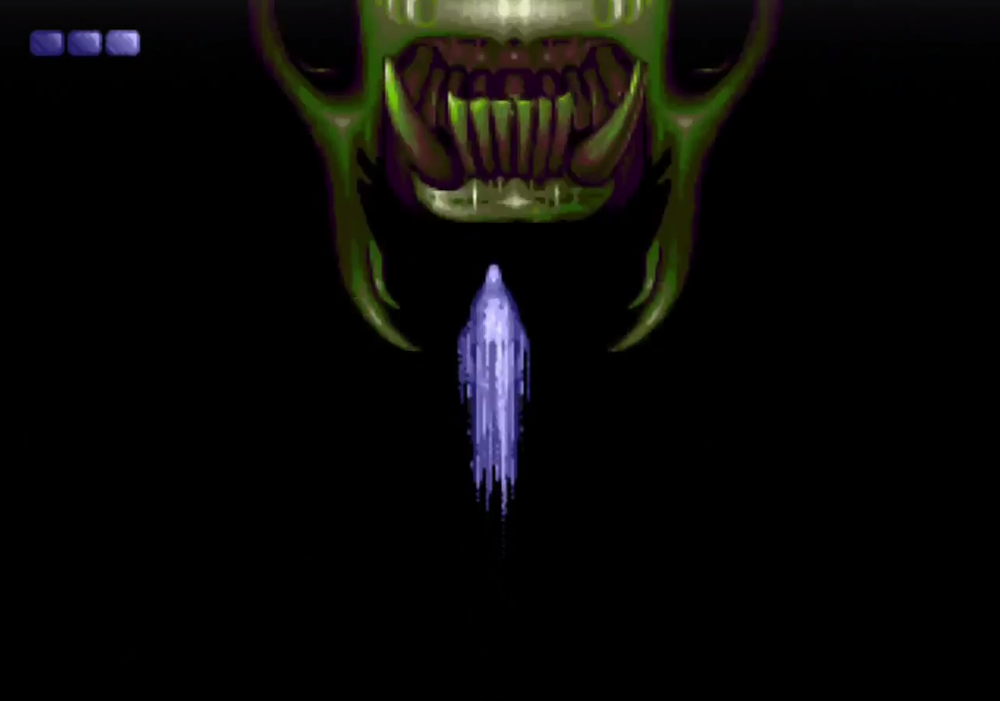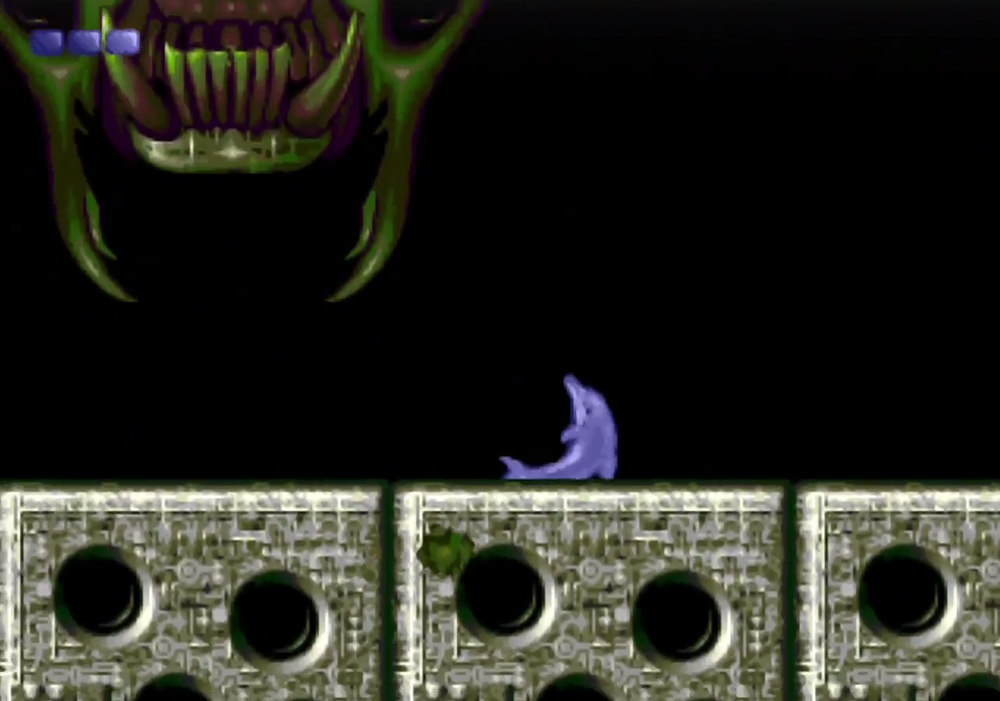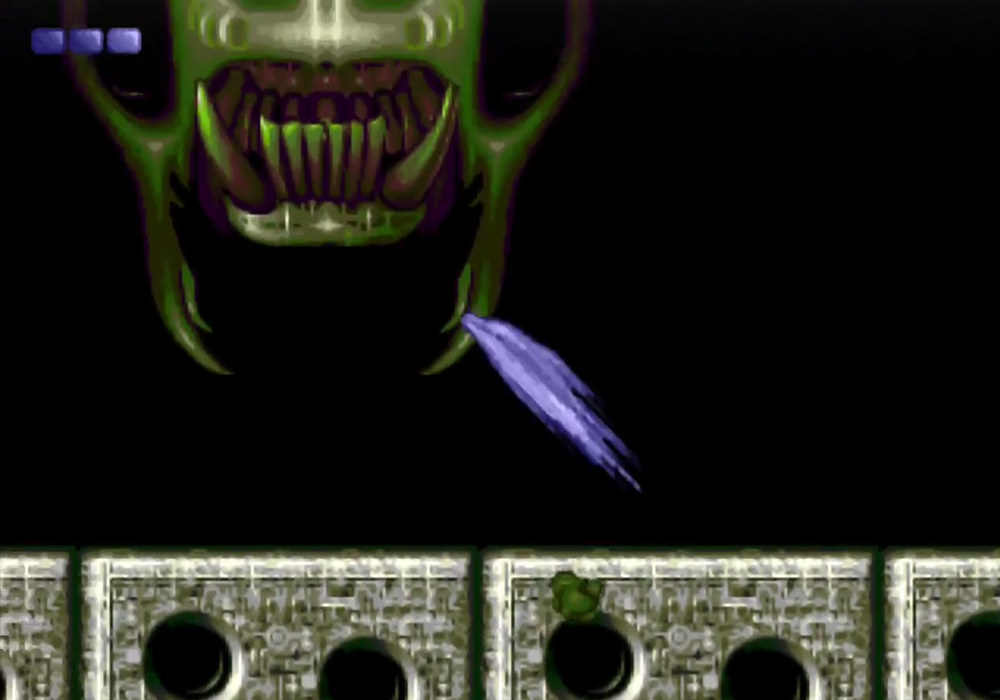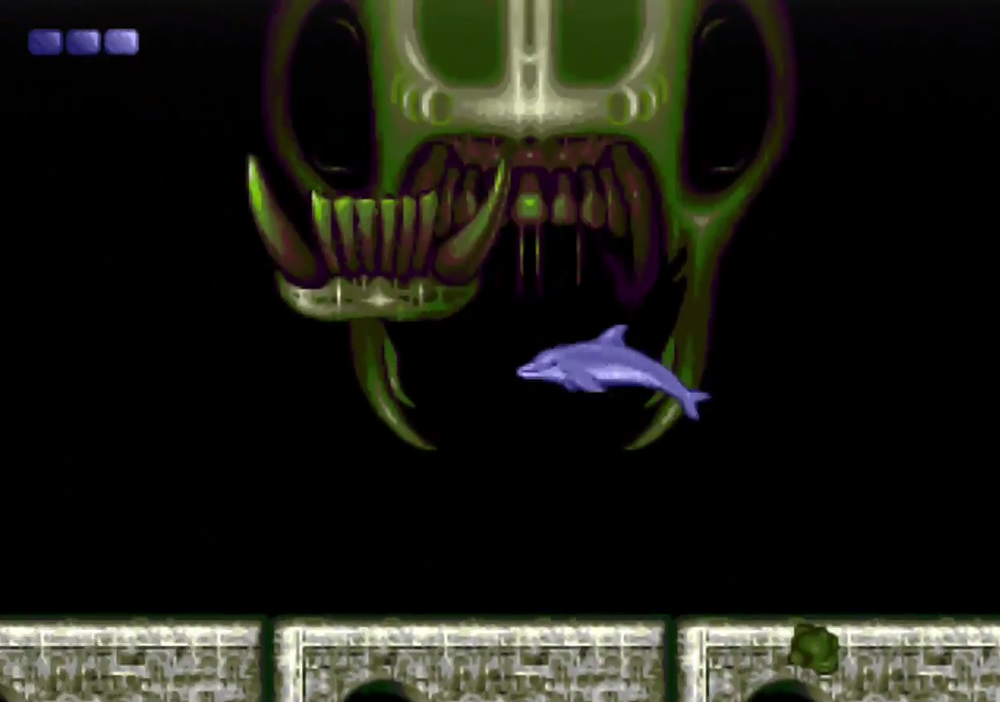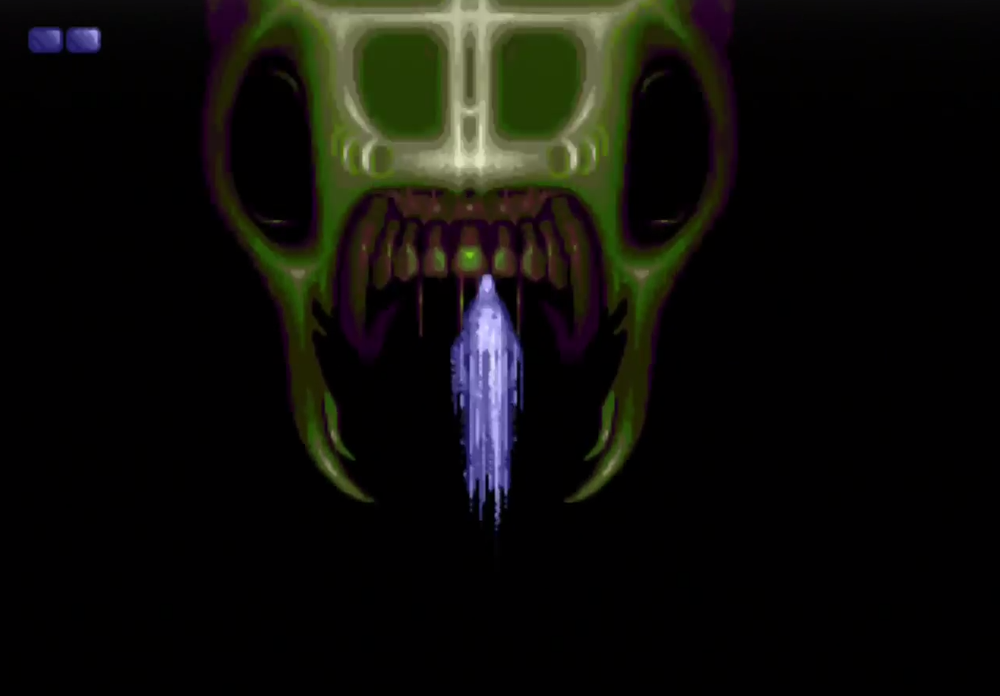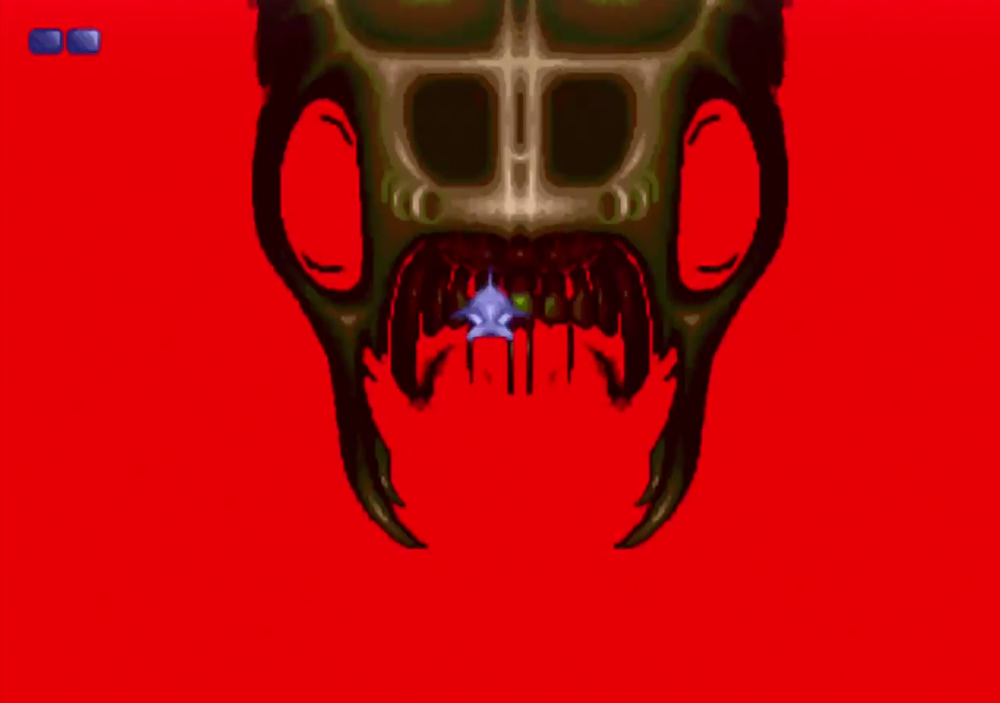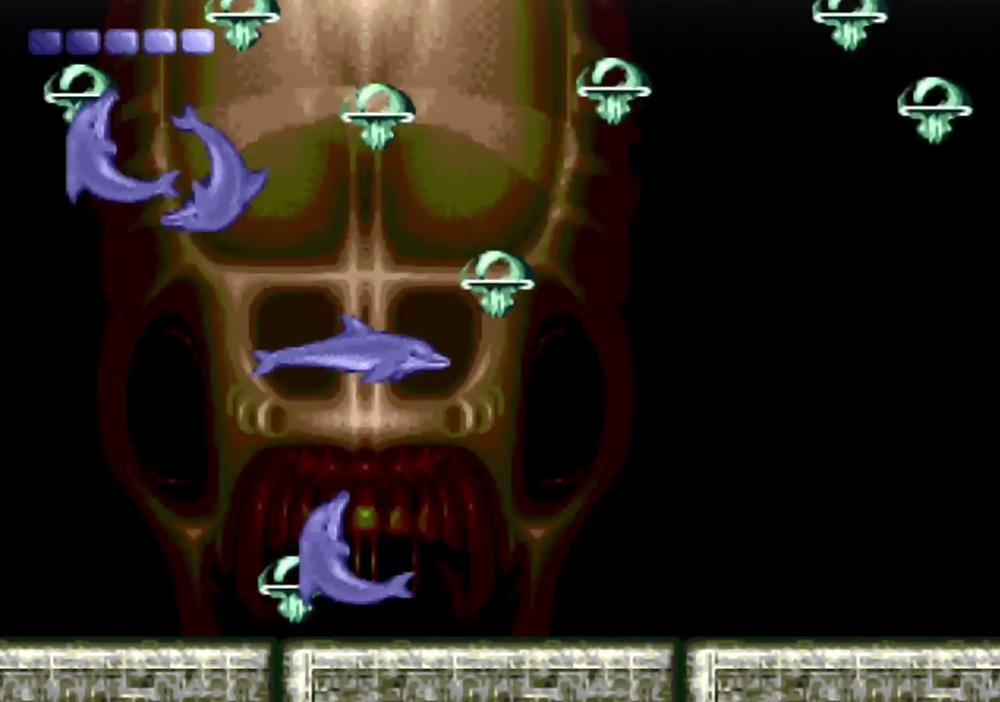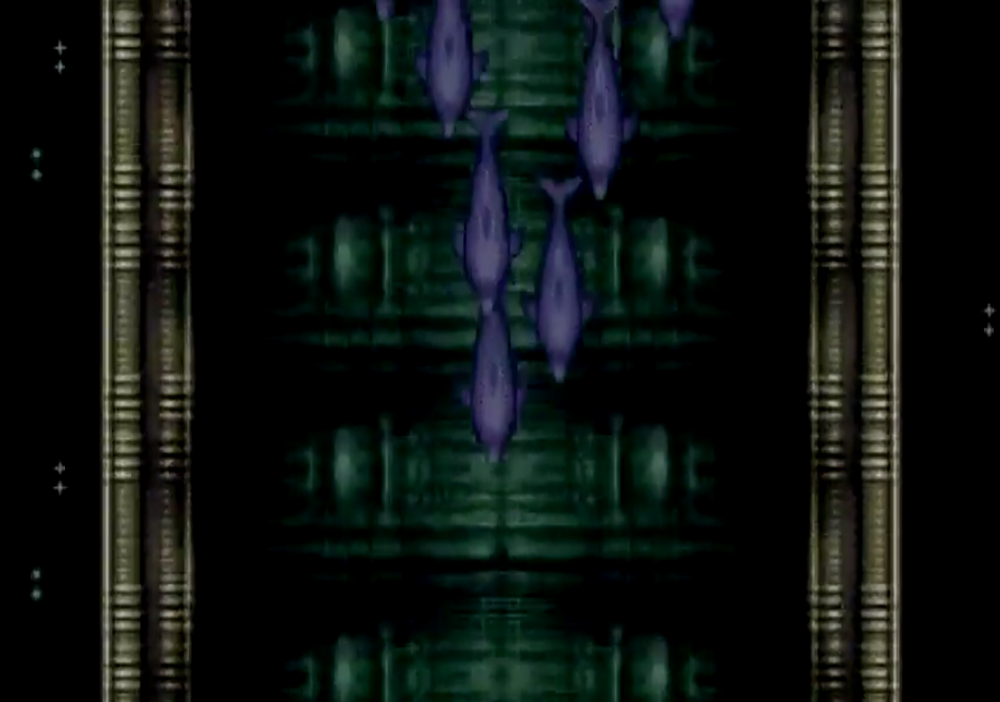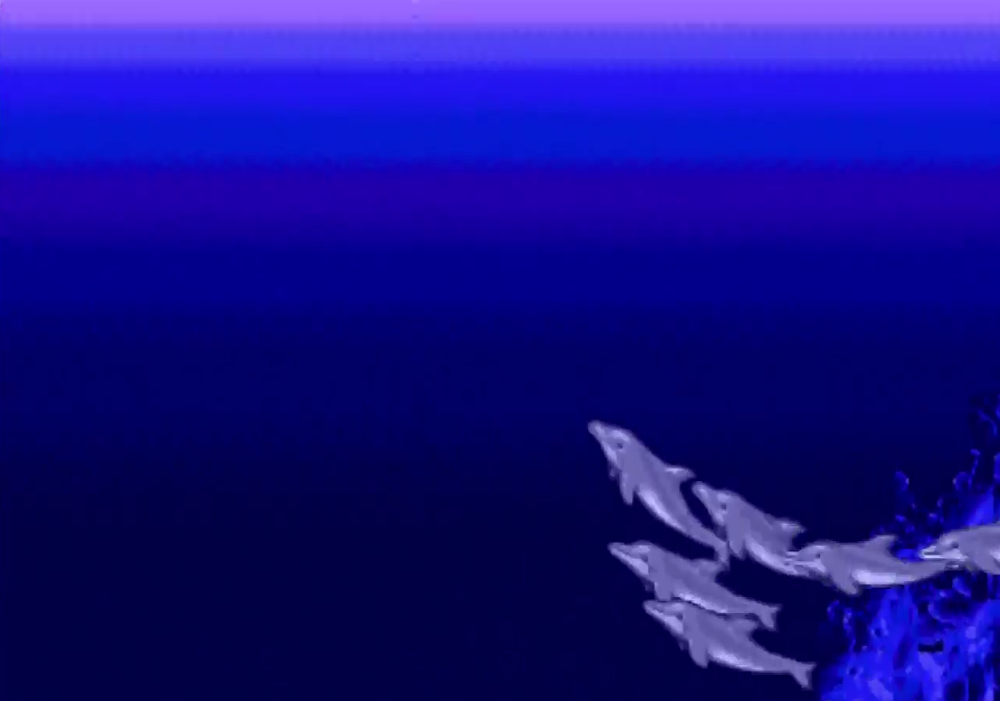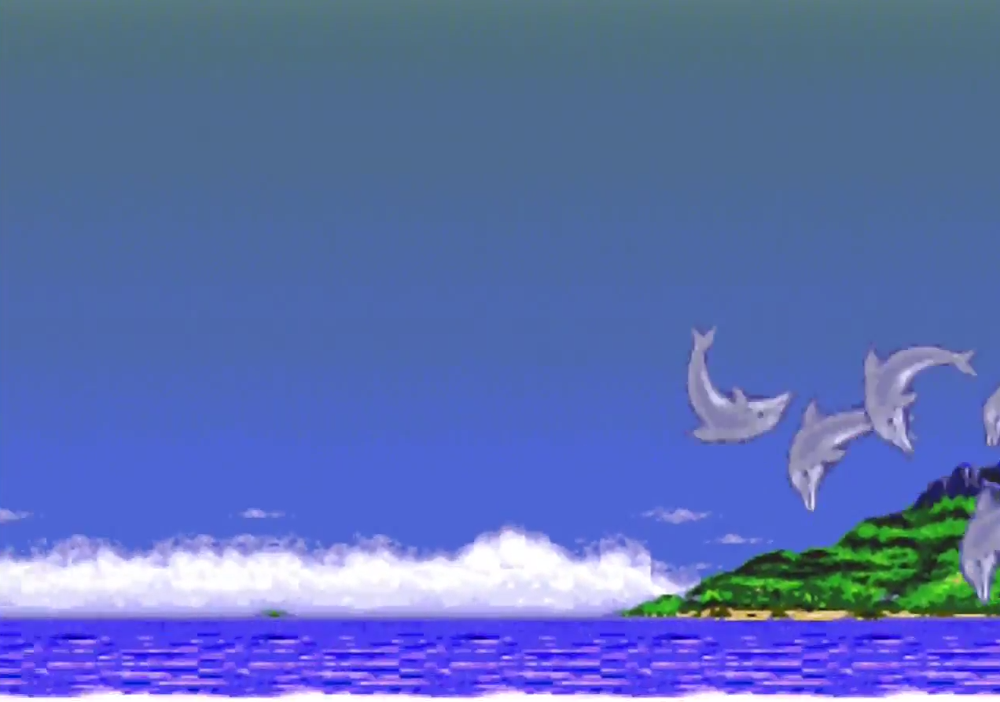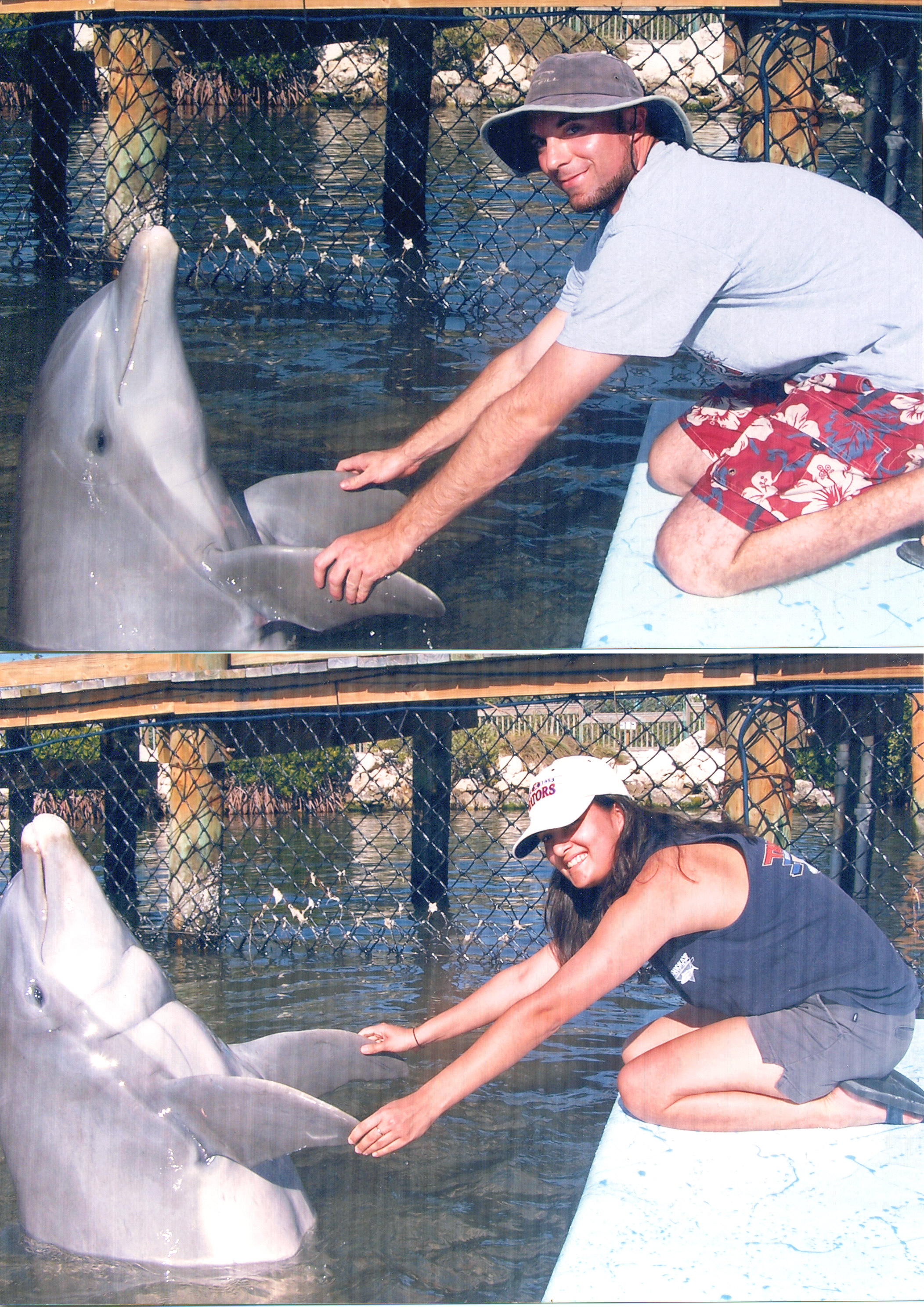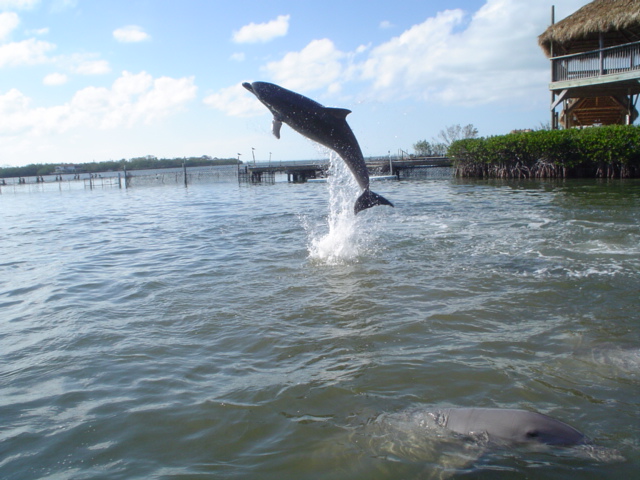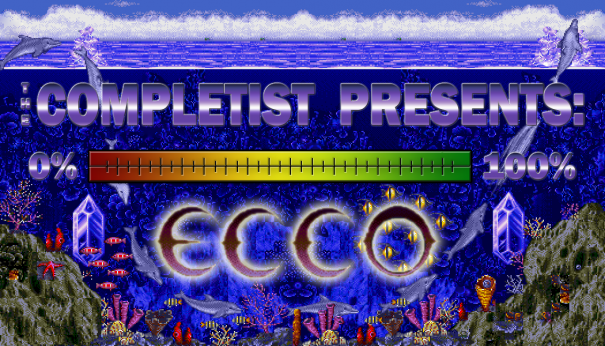
The Completist
The Ultimate, Most Comprehensive Ecco the Dolphin Feature Ever Written
Ecco the Dolphin is one of my, if not my favorite game… ever! Everything works together: the ocean is colorful, full of surprises and mysteries; the fast and responsive controls let you speed through the water and into the air; and the amazing out-of-this-world audio backdrop supports the incredible atmosphere. All of these factors allow you to literally dive into a believable world that will enthral you.
Of course, with Ecco being one of the most difficult games on the Sega Mega Drive, lots of drowning and death harassed me until I mastered the controls. It’s something you need to be aware of: take your time. Familiarize yourself with the stages and their difficult parts, and take breaks. By keeping persistent you will be rewarded with visiting some of the most amazing places in a video game that you will ever experience.
My favorite parts of Ecco include sliding on the arctic ice sheets, diving through the endless mazes in Atlantis, and being carried by a huge Pteranodon in Earth’s prehistoric times. Finally, I think the story sets up one of the coolest science fiction tales I know to date, including time travelling, outer space and some of the most terrifying aliens I’ve ever seen in a game!
When you grow up with siblings, you’re exposed to many things you normally wouldn’t be. My brothers had to attend my band concerts and ballet recitals, and I had to be a spectator of their baseball games and video games. I did actually participate in many of these video games, but there were only a few in which I actually dedicated my own free time. Ecco was one of those games, and I found it very easy to commit to because it was more intuitive than technically oriented.
As a right-brained introvert, I could connect with this game style, and with my interest in nature it was a perfect match for entertainment, at least in the virtual world. There were still enough island barriers, jellyfish popping and shark bonking to keep it manually fun, but some stages were a test of patience when I found myself stuck in those poetic riddles.
Uncertain of what I was searching for, (and having all the time in the world as a kid) usually my subconscious plan was to cruise through the underwater mazes, in meditation fashion, until the solution finally “clicked.” When I look back at the experience, using the echolocation tool in a more strategic manner would have saved me time, but I often wasn’t interested in using it unless I absolutely had to. I enjoyed this feeling of isolation and would even become aggravated by my lost dolphin friends I encountered at several stages which I had to lead to safety (and whom were on my tail the rest of the stage!). On the other hand (or flipper), consequently if I found myself swimming around alone and aimlessly for too long I would start to get lonely in the big deep blue and once again become compelled to search for my missing pod for company. Although I never finished Ecco as a child, the game left an impression on me that I feel to this day.
My goal in creating this Ecco the Dolphin article was ultimately, collaboration. I wanted different perspectives on the game mainly because I had such little experience with it myself. This game has achieved cult classic status and retains a small, but fervent fan base. I wanted to do this right and get input from people who were experienced with the game. Since Arkonviox is a good friend and collaborator, not to mention the founder of the Arkonviox Network (and a walking Ecco the Dolphin encyclopedia), I asked him to write the part 1 intro. I also reached out to Klaimen from Caverns of Hope, another fantastic fan community, and asked him to write the foreword to part two. And finally, there was my sister. She played Ecco when we were kids, a lot more than my brother and I. I needed a nostalgic perspective on Ecco that was close to home and she provided that beautifully. Thank you all for your contributions to this column!
Now that the collaborative part is over, it’s time for me to get down to business. Was I up for the challenge? Was it possible for me to beat one of the hardest Sega games ever made? Without cheating? Yes, it was actually. And I’m going to tell you all about it here. I’ll present all the gory details and my personal perspective (as someone who lives in Florida and has extensive experience with many forms of marine life) on this completely unique and original gaming experience. I am going to make comparisons to the real ocean and the creatures in it. I am going to use scientific names when I describe the wild life. I am going to nit-pick inaccuracies in Ecco that I found amusing. But most of all, I am going to celebrate this uncommon and intricate game. There really is no other game like it, to this day.
The first segment of Ecco’s adventure finds him swimming through a tropical sea where he is greeted (and attacked) by all manner of marine life. Some of these animals are what I would consider fictitious, such as the “Sea Leeches” that latch onto Ecco and suck him dry, but much of the life is true to reality, albeit, sometimes swimming in the wrong ocean. Now, to really know how accurate this game is you would have to ask Ed Annunziata himself because we are talking about pixels here, not actual creatures. So without his direct involvement, I figured I would give the painstaking task of identifying these creatures a shot. One thing that I made an assumption about right off the bat is that the first six levels of Ecco (as well as several others) must take place somewhere in the Caribbean. Why? Because the marine life you encounter in the game mostly resembles the Caribbean variety, especially the invertebrates (although not so much the fish). Some of the staples of Ecco’s coral reef environment appear to be several types of Sea Fans, Sea Rods, a few species of stony corals as well as some types of sponges, tunicates and starfish. I have put together comparison shots and descriptions below for reference:
Sea Fans/Sea Rods:
Bent Sea Rod (Plexaura flexuosa)
Pinnate Spiny Sea Fan (Muricea pendula)
Sea Fans and Sea Rods or as many of us divers call them here in Florida: “Gorgonians”, are a staple of the Caribbean reef ecosphere. You literally can’t get into the water near a reef and not see them attached to rocks everywhere, gently swaying in the warm Gulf Stream currents like trees in a massive underwater forest. They are truly a sight to behold. I feel that they were used in Ecco in order to give the reef a feeling of movement. Even though there are no coral animations in Ecco, the Gorgonians add quite a bit of realism to the environment.
Stony Corals:
Staghorn Coral (Acropora cervicornis)
Symmetrical Brain Coral (Diploria strigosa)
What reef would be complete without hedges of branching stony corals and mountains of circular brain corals? Both of these are present in Ecco and they resemble very closely the species I listed above from the Caribbean. They are more subtly seen in Ecco than in the wild but they do add to the overall feel and detail of the reefscape. In reality however, they take up a higher percentage of their natural environment than what is displayed in Ecco.
Sponges:
Fire Sponge (Tedania ignis)
Stove-Pipe Sponge (Aplysina archeri)
Brown Tube Sponge (Agelas conifera)
There are quite a few varieties of sponges seen in Ecco (and I didn’t list them all). They can be found in all parts of the world from tropical to temperate to arctic seas alike. However, the sponges found in Ecco appear to be native to the Caribbean. In fact, they resemble the sprites so closely, I would venture to say that these were the actual species the sponges in the game were based on. Especially Aplysina archeri which appear to be practically identical. And as you can see from the screen shots, sponges are very rich in color and add a splashy touch to Ecco’s home in the tropics. This probably also explains their liberal use throughout the environment of this game.
On an amusing side note, a couple summers ago I was diving with my in-laws down in the Florida Keys. My sister in-law Dawn, brought a beautiful orange sponge up to the surface and asked me to identify it. I wasn’t sure of the species but I told her not to let it come into contact with air because if sponges are exposed, it can damage them. I then instructed her to put it back underwater and “squeeze” it to make sure all the air came out. Well, unfortunately for her (and later me) it was a fire sponge! Seconds after she squeezed the sponge she began to scream from the burns on her hands. Yes, they don’t call them fire sponges for nothing! I will never to this day live that one down. The picture below shows poor Dawn soothing her hands with some ice cold water shortly after the sponge attack. Sorry Dawn!
Starfish/Anemones:
Mottled Red Sea Star (Copidaster lymani)
There appears to be only one type of non-brittle starfish present in Ecco. Luckily, there is also only one species of star fish in the Caribbean that resembles the sprites in Ecco which is Copiddaster lymani. This actually makes sense from an environmental standpoint. Most of the other varieties of star fish in the Caribbean such as brittle stars tend to hide underneath rocks and in crevices so they aren’t frequently seen. Good job on the creator’s part for this.
Banded-Arm Brittle Starfish (Ophioderma appressum)
The Banded-Arm Brittle Starfish is a common sight here on Florida’s reefs and throughout the Caribbean. Brittle Starfish in particular are prone to move fast, at least by starfish standards. People often mistake them for Octopus in many cases. I found their use in Ecco intriguing but inaccurate as the game designers saw fit to have them floating around the levels in a circle of motion. While you will see these starfish in groups in the wild, you are much more likely to find them under a rock than out in the open. But it was a nice touch none the less.
Giant-Tube Dwelling Anemone (Cerianthus sp.)
Tube anemones can be found in all areas of the ocean in pretty much every climate. It is also quite difficult to distinguish between different species in many cases. But since we are in the tropics and particularly, the Caribbean, we are going to assume that this particular anemone is of the Cerianthus variety, a Caribbean native. I’m a little disappointed that anemones weren’t used in Ecco as potential “bad guys” since they do give off a nasty sting and tube anemones especially, prey on fish. We all know Ecco isn’t a fish but it would have made a better and more practical villain than a giant sea horse (more on that later).
So overall, Ecco’s reef environment, species-wise at least, is fairly accurate (although placement is another issue altogether). But that still leaves the question of the fish. Overall, there are a fairly small amount of fish species in Ecco the Dolphin which are used in many of the different environments, despite the fact that they are all tropical species. We will take a look at those next.
Ecco’s fish species appear to be a combination of Pacific, Indian Ocean, Caribbean and Circumtropical varieties. Which is fine, except for the fact that they are all swimming together in the same ocean! I can forgive this transgression however because like the corals you will find in the game, Ecco’s creators also decided to use real to life species of fish. This impressed me, especially the fact that this game was made over 20 years ago on a 16-bit platform. This is something a modern AAA game like Call of Duty Ghosts couldn’t even get right with their “incredible” 3D scuba diving environments. They had Kelp growing on a tropical reef! There’s no kelp growing on Ecco’s reef which means Ecco got it right!
Here are some examples of Ecco’s fish and comparison shots to their real life counter parts:
Balloonfish aka “Spiny Puffer” (Diodon holocanthus)
Balloon fish, also known as Spiny puffers live in almost all tropical seas around the globe. So their presence in Ecco makes sense in all environments except for the cold water areas. One thing I always found comical about puffers is that when they are portrayed in any type of entertainment media they are almost always “blown up.” In fact, you will only see puffers in this position when they are being attacked or threatened in some way. You will generally NOT see them this way while scuba diving on a reef. Either way, kudos to the developers for getting the likeness nearly spot on.
Sergeant Major (Abudefduf saxatilis)
Sergeant Majors are what we Floridians like to call “garbage fish.” They are everywhere and they are pretty much useless. They don’t make for a good meal and they are generally too aggressive for aquariums. They also happen to be an Atlantic Ocean fish, which makes seeing them in Ecco’s tropical Caribbean based levels true to life. They are also seen schooling which is part of their true nature as they tend to swim in massive groups in the wild. They get their name from a Sergeant Major’s rank insignia which is striped and yellow.
Spotfin Butterflyfish (Chaetodon ocelattus)
This next fish could have been any number of Butterflyfish from anywhere in the world (there are so many that look similar) but since we are keeping with the Caribbean theme, the one that fits the pixels from Ecco the best would have to be the Spotfin Butterflyfish. They are a fragile and active fish that mate for life and tend to be seen in pairs flitting about the reefs here in Florida. They are a difficult fish to keep alive in captivity because of their high metabolism and voracious appetite for live corals. Although I think they were an elegant and recognizable choice for Ecco, as far as Butterflyfish go.
Moorish Idol (Zanclus cornutus)
Other than possibly the clownfish, the Moorish Idol is one of the most recognizable fish in the ocean. You see them everywhere. Screen savers, soap bottles, movies, video games, TV shows, art designs, Finding Nemo, you name it, the Moorish Idol has probably been there. They hold the distinction of not only being my favorite fish in the entire ocean, but also one of the hardest reef fish to keep alive in captivity. They just don’t adapt well for some reason. And this is initially what drew me to this magnificent fish (because as I’m sure you know, I love a challenge). I think these traits make them a perfect fit for Ecco, even if they did show up in the Caribbean rather than the Pacific. Kudos again to Ecco’s creators for including this fish and making it’s likeness so true to life.
Maroon Clownfish (Premnas biaculeatus)
Even though the shape isn’t quite right, I can’t imagine what other type of fish this could possibly be other than a Maroon Clownfish. Plus, it makes sense to include some kind of clownfish in this game considering the fact that they are the most recognizable fish in the ocean, although in this case, the wrong ocean (they are from the Pacific). Maroon clowns also do not school in the wild as they appear to do in Ecco. They are solitary, genocidal fish by nature and will kill other clownfish of the same or even slightly related species (no dating your second cousin here). However, they tend to settle down with a mate in their symbiotic anemone of choice and guard it with their puny lives. I feel they make another good choice for Ecco for the simple fact that everyone knows what type of fish they are.
Regal Angelfish (Pygoplites diacanthus)
Again, not a perfect representation of a Regal Angelfish, but another fish that to me is unmistakable. The Regal Angelfish is found in the Pacific and Indian Oceans as well as the Red Sea. The Red Sea variety tends to be more vibrant than its counterparts. For that reason I am going to assume that the Regal Angelfish represented in Ecco is of the Red Sea variety due to its vibrant color. This fish was another excellent choice for simply being a stunning and recognizable reef fish, even though it’s in the wrong ocean.
Doublesaddle Butterflyfish (Chaetodon ulietensis)
Another fairly accurate looking butterfly fish. This one is called the Doublesaddle and is native to the Indo-Pacific region of the world. So again, not a Caribbean native like all of our coral species but a nice addition to the already blooming population of fish in Ecco the Dolphin.
Creolefish (Paranthias furcifer)
Last but not least is the Creolefish which can be found throughout the Caribbean as well as the Eastern Pacific. They are a schooling fish in nature and prefer deep reef habitats (where you tend to see a lot of them in Ecco). When I saw this fish swimming around Ecco’s environments I immediately had a pang of recognition. The resemblance from the pixels in game is fairly close and the purplish coloration makes for a nice addition to Ecco’s world.
Now that I have compared and identified the majority of the sea life found in the tropical regions of Ecco, (and some that managed to find their way out of the tropics as well) I would like to bring you along on my journey playing through Ecco the Dolphin, from start to finish. It’s a somewhat kooky but also charming ride that takes Ecco not only trotting across the globe, but also through time and space. As I said before, there really is no other game that even comes close to the exclusive rarity this game offers. I’m ready if you are. Let’s begin.
Ecco’s opening scene begins in a crisp, blue, tropical lagoon surrounded by vibrant sea life. In this “Home Bay” you’re fellow dolphin Pod mates swim gleefully through the sparkling water while jellyfish, tropical fish and corals flesh out the scenery. It’s a majestic scene which encourages you to explore the vivid beauty that surrounds you. However, looks can be deceptive, something sinister is amiss.
As Ecco takes his first joyful leap from the sea, there is a brilliant flash of light, followed by a whirlwind of terror that sweeps away all life from the lagoon. Ecco is caught in the revolving vortex but is tossed back to the sea, apparently unharmed. Something has happened, vicious and sinister. Perhaps we can call it a “harvest” of sorts. It is now readily apparent to the player that Ecco’s forthcoming adventure is far more than simply a “Dolphin Simulator.” Something much deeper is amiss.
The first section of Ecco the Dolphin sees Ecco gliding through the water at top speed in search of any sign that might lead him to the answers about this tragic, otherworldly event. Upon leaving his home bay, Ecco traverses across five tropical reef themed levels; “Medusa Bay”, “The Undercaves”, “The Vents”, “The Lagoon” and “Ridge Water.” While in Medusa Bay, Ecco encounters an Orca (on a tropical reef???) who gives him this sage like advice:
Big Blue…. That could only mean one thing. Ecco will no doubt be heading north. But first, there are many sights to see and adventures to be had here in this tropical cavern of perplexities. One of the major contributing factors to your journey appears in the form of large, crystal looking structures known as “Glyphs.” There is no real explanation yet as to why they exist (but the more of them you encounter, the more things begin to become clear) but they tend to either help you or hinder you. Some act as “Keys” that Ecco must absorb in order to progress, or on the flip side, as barriers to impede Ecco’s progress. And yet there are others that act as beacons of information, giving Ecco often “cryptic” messages to help him on his journey. In the Sega CD version, they even act as check points throughout the levels (which makes the CD version quite a bit easier than the Genesis original). And last but not least, (and honestly this is where the game bears one of only a few similarities to other games of the time) you have the Mario-esc “Invincible Power” Glyphs that not only make Ecco invulnerable to damage, but also give him unlimited air for a short amount of time. These particular Glyphs are typically found deeper in the reef caverns and often times act as a sort of reward for battling through a difficult situation. All I can say is, thank God they exist because certain parts of this game would have proven nearly insurmountable without them.
The more you glide through Ecco’s ambiguous underwater environment, the more you will find that “singing” is an invaluable tool. Bouncing Ecco’s sonar waves off of the reef walls becomes almost like a game of pong. Once Ecco’s song returns, it rewards him with a small port hole of sight for the surrounding area which proves helpful, but limited. We’ll call it a map of sorts. Limited or not though, suffice it to say that without it, Ecco would find himself as blind as the poor sighted moray eel.
Speaking of singing, Ecco the Dolphin has some incredibly atmospheric music. It fits the game like a new-age laced glove and after playing the superior Sega CD version of the game, I can’t imagine going back to the original Genesis soundtrack. The Genesis version lacks depth in the music and to me, suffered a lot from what I like to call “the Genesis ting.” What I mean by this is that a lot of Genesis games (even exceptional ones like Ecco) tended to suffer from the lacking soundboard. Not sure what I’m talking about? Listen to this:
The Genesis Ting
Alien 3:
To play the media you will need to either update your browser to a recent version or update your Flash plugin.
Ecco:
To play the media you will need to either update your browser to a recent version or update your Flash plugin.
If you’re a Genesis fan, then you should recognize the sound I am talking about immediately. It’s the “rrraaaaaaaaooooooorrrrrrrr” noise you hear in the music. Both of the above games use it liberally. It’s a hardware related sound or perhaps a music technique that was used in more Genesis games than I can possibly count. I’m willing to bet that if you were blind folded and didn’t know any better, you wouldn’t be able to tell one sound track from another. The Genesis Ecco isn’t one of the worst offenders, but it did use this technique pretty regularly. And while I’m sure many look at that sound as the Sega Genesis “calling card”, I find it somewhat annoying.
However, certain developers and artists, most notably, Yuzo Koshiro, were able to make the Genesis soundboard sing when they took the time and effort to push it to its limit. I just don’t feel this was the case with Ecco. I know there are some who will disagree with me but I think that the Genesis Ecco soundtrack is merely passable, while the CD version is quite remarkable. Here are two of my favorite tracks from each version of the game for comparisons sake:
Medusa Bay, Genesis:
To play the media you will need to either update your browser to a recent version or update your Flash plugin.
Title Track, Sega CD:
To play the media you will need to either update your browser to a recent version or update your Flash plugin.
If you would like to hear all of the sound track from both games you can find them at Caverns of Hope.
Getting back to the game itself, as Ecco swims through the tropical abyss in this first region of the game, many trials and puzzles await. The first major one takes place in “The Undercaves”, where Ecco will find his first challenge in the form of a giant Octopus!
This particular Octopus is not a particularly friendly invertebrate. Ecco must swim by it like a lethargic snail if he hopes to survive the encounter. Any dash or sudden movement will startle it into action, grabbing at Ecco with its suction-cup-infused glue like tentacles. A couple good smacks will knock Ecco into the gloomy void permanently. This Octopus is one of several you will encounter throughout the game. Each with a slightly new twist to add to the challenge.
Upon initial inspection, I found this Octopus to resemble Entroctopus dofleini, the largest Octopus in the world (but who is found in temperate to cold climates, not the tropics). After all, this particular specimen appears to be at least 20 feet long, no doubt weighing hundreds of pounds! But after closer inspection, this Octopus actually more closely resembles Octopus vulgaris (pictured above) which is a Caribbean variant but only reaches 3 feet in size. Let’s just call it a strange hybrid shall we! Either way, the sprites look great and the Octopus poses an interesting challenge. However, having kept Octopus myself over the years, I will have to say that they are quite friendly and intelligent, not the angry, hostile creatures they appear to be in Ecco.
Continuing on, Ecco will also encounter walls of spiky (Murex?) shells that he must blast through, hordes of pointy puffers best avoided, Maxima Clams that feed Ecco health in the form of tasty bubbles, horrid Sea Leeches that grab Ecco and refuse to let go, Manta Rays that for some reason let off a “sting”, despite the fact that they lack a stinger and also helpful brittle stars that apparently destroy everything they touch. Avoiding most wildlife in this game is my best recommendation when it comes to surviving in these labyrinths of underwater caverns.
A new environmental puzzle takes place in the area titled “The Vents” (and also in many other levels later in the game). Ecco will be forced to use his head (literally) to push loose pieces of rock into strong updrafts of water in order to traverse deeper into the depths. It makes for an interesting but occasionally frustrating test of Ecco’s ability to keep himself positioned “directly” behind the rock so that he isn’t swept away by the ripping current. If he is swept away, it’s back to the surface to start over again.
Another puzzle introduced early on is one of balance and patience. Using what I can only guess is a giant cone shell of some sort (it doesn’t look like any species I am familiar with), Ecco must maneuver the ever sinking shell to a breakable rock wall. Once he has positioned the shell in front of the wall it must be pushed through it. In many circumstances this is your only option for breaking through this otherwise impenetrable boundary. It takes a bit of skill as well as trial and error but it’s presented well enough for a simple puzzle solving exercise.
Last but not least we have our friendly but helpless brittle starfish. They appear magically in a circular spin of spiky legs when Ecco enters certain rooms. Their purpose is generally the same as the aforementioned cone shell, to break through an impassable rock wall. In order to do this, Ecco must use his sonar to direct the starfish where he wants them to go. This can on occasion, be maddeningly difficult. Many times you will run out of air in the process or simply blast the starfish into a coral outcropping where they will become irretrievable. You are also required in one sequence to actually move them past a giant Octopus, which is actually harder than it sounds.
One favorable thing about these brittle stars though is that they destroy most enemies they happen to touch. So if you can manage to blast them in the right direction with Ecco’s sonar and into a group of say, irritating Stone Crabs, you’ll be having crab claws for dinner. It’s lovely touches like this that make these sometimes frustrating challenges worth it. They rewarded you with a relieved sense of accomplishment and most importantly, Ecco will be able to progress.
Once Ecco has cleared the tropical caves of the Caribbean zone, it is time to take the Orca’s advice and head north. And in what I considered a nice touch, Ecco is required to swim through the “Open Ocean” in order to reach his next destination. What’s in the open ocean? Not much really, well, except about 150 sharks! Literally, they are everywhere and they are none too happy that their only natural enemy (other than humanity) is flitting about in their wide open spaces.
While the sharks are great and many, the variety of them is few. In fact, only one to be exact. And from my best guess, they would appear to be Bull Sharks:
These guys are mean and give Ecco no shortage of hell before he manages to blast his way through them and to the final safety of the Arctic. The interesting part is, Bull Sharks are actually one of the more aggressive species in real life, so their aggression towards Ecco makes some sense. Although in reality, I doubt a Dolphin would be able to simply hit the bottom of the screen and speed dash all the way to the end. Oops, gave that trick away… Shhhhhh!
Once Ecco reaches the Arctic, he is greeted by… more sharks! This time the sharks is question are unmistakable. They are no doubt Leopard Sharks. This assumption makes a lot of sense too considering that they are in fact a cold water shark. Not to mention they live off the Northern California coast where Mr. Annunziata resides. While you likely won’t find them in the Arctic, I thought it was a nice touch for Ed to include an animal from his home state.

Once Ecco finds his way out of the shark pit, it’s time to go exploring in this frigid ecosphere. Icy mazes, giant menacing King Crabs (that resemble spiders and even have eight legs for some reason, but giant sea spiders don’t make sense in the Arctic, King Crabs do), crushingly brutal swarms of ice blocks and of course, Big Blue himself all await in this frigid abyss. And of course let’s not forget the infamous ice sliding. Klaimen mentioned in his introduction that sliding on the ice was one of his favorite aspects of Ecco the Dolphin. I would have to agree here. It is quite a bit of fun. It was a clever choice by the developers to add this in, especially when it is used for discovering new caverns in the seemingly endless ice.
The arctic environment of Ecco the Dolphin really only consists of three levels: “Ice Zone”, “Hard Water” and “Cold Water.” All three are similar and involve many rapidly moving ice blocks that will crush Ecco the moment he gets too close. Learning the timing of these sometimes frustrating cubes makes for an easier traverse. Also learning how to avoid the giant King Crab/Sea Spiders is another path to victory. All in all, this zone is difficult, but nothing compared to what is to come later in the game.
Make it to “Cold Water” and you will finally find what you came for. Big Blue is here! A gargantuan sized Blue Whale with great wisdom of the world and its history. Big Blue knows what to do and he isn’t shy about giving you his help:
So Ecco must meet someone or something called the “Asterite”, apparently the oldest life form in the sea. Big Blue also informs Ecco that the “storm” you witnessed in your home lagoon only happens once every 500 years. All life in the region of the storm apparently vanishes into thin air. Why this happens, he does not know. But luckily, he does know the location of the Asterite: “The Deep Water Zone.”
Upon leaving the arctic zone, Ecco is treated to a Sega CD exclusive level in the form of “Open Ocean 2”, which is basically identical to the original. It appears to exist simply to let us know that Ecco is traversing to wherever the Asterite is hiding. When Ecco finally reaches the remote island he is in search of, he must traverse deep into the reef to find his reclusive companion. And when he finally reaches his destination, he discovers something that can only be described as genetic:
Wow! Is it a double helix? A genome of some sort? I can’t help but think that the Asterite is representative of Mother Nature herself. The genetic code of every organism on earth stored in one massive, genetic chain of information. Fascinating… And as it turns out, the Asterite has some more information for Ecco:
So apparently, this particular double helix knows Ecco quite well, although it isn’t revealed how or why. It offers to give Ecco special powers that he will need to save his lost Pod in exchange for his aid. The Asterite you see, is injured so to speak. He is missing one of his orbiting “globes” and needs it in order to help Ecco on his quest. Retrieving the globe however, takes Ecco into the realms of science fiction. It is revealed that he must travel to the long lost sunken city of Atlantis! There he will find a time machine the Atlanteans built that will take him 55 million years into the past. It is there, in the prehistoric age of dinosaurs that he can retrieve the Asterite’s lost globe. And there you have it, off to Atlantis we go!
Not so fast! Are you forgetting something? This is the Sega CD version of Ecco which means, bonus levels! So rather than Ecco magically appearing in Atlantis after meeting the Asterite (which is what happens in the Genesis version), he must instead travel there via the “Volcanic Reef”, “Ship Grave Sea”, “Wreck Trap”, “The Sea of Silence”, and finally, “Deep Gate.” Bonus levels are always a nice thing, especially when the game as a whole makes more sense because of them.
These “volcanic rock” looking bonus levels are once again loaded with environmental puzzles (and environmental graphics tiles that were later used for Ecco 2). Most of them center around finding Key Glyphs to open inaccessible passages. Although I will have to admit, some of the puzzles are a bit different, and difficult! One in particular can be seen below:
One slightly amusing situation finds Ecco attempting to use Green Sea Turtles in the same way he uses rocks. That is, to block the flow of a ripping current. Ecco must swim up to the turtles, give them a gentle nudge and then maneuver them around until he reaches the bottom of a vent. I continually felt bad for the turtles I was bumbling around with. Almost like an Orca playing with its food, flinging a helpless seal through the air in a gleeful display of power. But suffice it to say that the turtles came out of this situation unharmed.
Also in the volcanic depths we find several areas with sunken ships. These ship wreck levels aren’t quite as difficult as the initial volcanic islands, but have their own challenges. One of the central ones being, having to deal with multitudes of angry, spiny puffers:
All in all this section of the game is all about finding Key Glyphs and maneuvering through vents. There are a few stand out instances though, such as having to balance a piece of rock on Ecco’s nose in order to fling it over a crevasse and onto a breakable wall (insanely hard) or filing a barrel with bubbles in order to help you traverse your way up a downward ripping current (also insanely hard). But once Ecco finds his way to the “Deep Gate” of Atlantis, the real fun begins.
Oh how the mighty have fallen! The stories of Atlantis you heard are all true! A mighty, but ruined city with a maze of catacombs so vast, even Ecco’s precision sonar won’t be enough to conquer it. Atlantis, which consists of “The Marble Sea”, “The Library”, “Deep City”, and “City of Forever” is one gigantic maze. The appropriately titled “City of Forever” is exactly that, an insanely long underwater perplexity.
Atlantis is filled with naked statues, sharp and deadly crystals, mild electric shocks, helpful yellow starfish, more Leopard Sharks, swarms of stinging jellyfish and multitudes of marble chunks to move around because apparently, Atlantis is crumbling at its core. The marble pieces, similar to the rocks and turtles that came before it, come in handy when having to traverse down a rushing current. The yellow starfish can also be used exactly the same as before when Ecco needs help blasting away baddies or slamming through an impenetrable passage (or in the case of Atlantis, large chains). But what really sets Atlantis apart from the rest is the sheer size of it all. It is a truly daunting experience and quite easy to get lost and surrender all hope of ever finding your way out. Throw in some of the most insane jumps Ecco must make in the entire game and you have one hell of a difficult romp through this Atlantean concrete jungle.
But the real purpose of Atlantis is to advance this increasingly sci-fi inspired story. When Ecco reaches “The Library” there are a multitude of informational Glyphs that he can converse with. Upon speaking with the Glyphs, Ecco discovers that Earth is at war with an Alien species appropriately titled “The Vortex.” The Vortex are located on the third planet of a distant star system named Cassandra. It is thought by the Atlanteans that the Vortex home world is slowly dying, causing the species to gradually starve to death. Every 500 years, when there is a clear path to the Earth, the Vortex begin to feed, with each feeding growing larger to accommodate their increasing need for nourishment. When the Atlanteans began to suspect that these aliens were “harvesting” the Earths creatures for food, the Vortex fired an energy beam from space that destroyed Atlantis. Luckily though, some of the Atlanteans managed to escape to the ancient past using a time machine they had conceived. While they were hiding in history, the Atlanteans created the mysterious Glyphs and scattered them throughout the sea in order to lead the future Ecco the Dolphin to his destiny, to save the sea.
Upon learning this, (and after an insanely long maze of death and destruction, courtesy of the City of Forever) Ecco must enter the Atlantean time machine and descend 55 million years into the past. The fate of Earth is now in Ecco’s hands, err… flippers:
Ecco arrives, 55 million years in the past! And what a terrifying prospect it is. Pre-History is loaded with top predators looking for a quick meal. But this is common place considering that we are after all, (although it seems the game developers were about 10 million years off) at the end of the Cretacious period. Creatures you will find here include; Trilobites (wrong time period), Giant Molluscs, squid like Cephalopods, helpful Pteranodons, vicious Dunkleosteus, ancient species of corals and last but not least, Giant Sea Horses! Yikes, that’s quite an assortment of ancient fossils come to life. But how accurate were the creators of Ecco with this antiquated lot of critters? Well, rather than go over what has already been written, I would like to refer you to a beautifully crafted article that makes for a perfect companion piece to this work. It was written by Hauke and it can be found HERE at Caverns of Hope. If you’re interested in learning more about Ecco’s age old friends, give it a read before you continue. Don’t worry, I’m not going anywhere.
The ancient past of Ecco the Dolphin consists of 5 areas: “Jurassic Beach”, “Pteranodon Pond”, “Origin Beach”, “Trilobite Circle” and “Dark Water.” Your first order of business upon arriving is finding the nearby Glyph which gives you these instructions:
Your friend the Pteranodon is near, sing his song and he appears:
The Pteranodon is a good friend to have in these dangerous times. He helps Ecco to reach places he normally could not. Other than this nice twist though, the majority of the Cretacious period is mostly about not running out of air and simply staying alive. The Dunkleosteus Eels make for formidable opponents, avoiding them if possible is always your best bet. The same goes for the numerous stinging jellyfish and annoyingly fast Squid-like Cephalopods.
But let’s also not forget our friends-in-the-wrong-time-period Trilobites. They are extremely fast and deadly. I believe in reality, Trilobites were more like Horseshoe Crabs in that they tended to stay on the bottom. Oh well, they make for formidable enemies none the less.
Also at this point in the game, there is of course your standard array of insane jumps that Ecco must perform:
And this time around, instead of ice cubes bashing Ecco into the side of the crevasse, we have ancient spiked shells which make his poor flippers bleed:
But the grand finale of them all, the final creature that I will identify in this biology lesson of a game, is a Gigantic Hippocampus erectus aka, a Sea Horse! Complete with angry babies in tow:
Why is this Sea Horse so angry? And why is it so huge? This I fear, is pure fiction. The largest a Hippocampus erectus gets is a whopping six inches. However, in reality, Sea Horses are ambush predators that prey upon small shrimps, and crustaceans. So, if there were a Sea Horse this large, I’d imagine it may not be so friendly. Good job Ecco team!
Finish out the Cretaceous period and Ecco finds himself face to… molecule… with an ancient version of the Asterite. This time around however, the Asterite is none too pleased to see Ecco. Turns out this won’t be as pleasant as your first meeting.
The Asterite didn’t tell us that we were going to have to steal a molecule from… himself! No matter, Ecco must accomplish the task and we are along for the ride. Getting the molecule poses quite a challenge. Patience and distance are key elements here. If Ecco gets too close, the angry Asterite lets off an electric shock that is anything but congenial. The only way to dislodge one of his orbs is to charge it 4 times. Not as easy as it sounds, especially when the orbs are continually spinning about in their seemingly biological fashion. We also can’t forget Ecco’s ever decreasing air supply. This “fight” is no cake walk.
But Ecco must persevere. And that he does, using his dashing ability, he dislodges an orb and is instantly transported back to the future, where the kind and noble Asterite awaits.
Ecco returns the orb and the Asterite speaks:
“Now I am whole again with all my power, thank you Ecco!
Now I will help you. I will give you new powers…
Use the Atlantean time machine to swim back in time to the hour of the storm…
You will be taken with your pod… You will see the unseen enemy.
Use this song to return to your home bay just before the storm.
With your new powers perhaps you will save your pod.”
And with that, Ecco is transported back to Atlantis, where he will once again make a leap through time. This trip though, he will travel to the instant before the Vortex storm hits. The vicious attack that took his beloved Pod.
Ecco appears, its Déjà vu. Back to the moment it all began. Back to the calm waters of his Home Bay. Again Ecco leaps, and again the storm spins, but this time, Ecco is swept up with his Pod.
And then for an instant, all is quiet. But when the scene reappears, Ecco is travelling upward, through a metallic “Tube.” Alien in its appearance and with stars in plain view, we could only be in one place, the Vortex mother ship. Space!
The tube is a difficult level, but compared to what comes next, it’s like a swim through a pleasant, babbling brook. Suffice it to say that the tube is an upward scrolling romp, similar to a shooter. There is only one speed, and death will come swiftly if even the slightest obstacle is touched. Ecco must use his sonar to blast away hunks of debris and protruding beams of metal in order to survive. Later, electric shocks will zap Ecco as he attempts to continue forward. Staying near the middle of the tube is your only option for survival.
What comes next, is quite frankly, one of the most difficult levels I have ever experienced in my nearly 30 years as a gamer. It’s harder than level 5-1 in Batman for the NES, it’s harder than level 6-2 in Ninja Gaiden, in fact, it’s probably the hardest damn level ever. And did I mention, it’s also Ed Annunziata’s favorite!
Interviewer: If you had to pick one stage you enjoyed creating the most, which one would it be and why?
Ed: Welcome to the Machine. It was just surreal and way over the top challenging.
Source: Gaming Furever
Ouch! There is also this little fact from the man himself about the legendary difficulty of this game:
Interesting, so worrying about people renting the game and beating it over the weekend was why Ed decided to make it so difficult, fascinating… Well, look no further, because here it is:
Complete with big headed aliens and a level that moves Ecco along in any which way it pleases. This is the level of your worst nightmares. And honestly, I mean that in the best way possible. It is an intricately designed and brutally challenging rollick through a labyrinth of which you have no control. You always feel that Ecco is just one flipper away from expiration. And in reality, he is. One wrong move, anywhere, and your dead, rinse, repeat, start over.
It took me three straight hours of playing this hysteria to finally, mercifully complete it. And there wasn’t a minute of it where I wasn’t completely terrified. It’s truly an amazing level in that regard. It managed to keep me on my toes for three full hours, always frightened that I was a split second from doom. This stage quite frankly must be experienced to be completely appreciated for all it’s dirty but wonderful tricks.
And so, when Ecco finally reaches the end of his self described “Machine of Hades”, he is greeted by an even bigger menace. The mother of all aliens herself, the Vortex Queen:
BOO!
And I will have to say, the Queen Alien of Ecco the Dolphin is presented in some of the most beautifully drawn sprites I have ever seen on a 16-bit console. I was literally shocked the first time I saw her. Bravo to the artists! Just look at this girl:
She’s the most beautiful, horrid, slick, yet sinister looking creation of the era, hands down. But while she is lovely in her own incongruous sort of way, beating her is a learning experience in timing and precision. Starting with her eyes:
Slam into them enough with Ecco’s dash attack and they burst into marvelous balls of green puss. And once her eyes are squished to goo, her perfect jaw line is next:
Remove that menacing jaw and the Queens final moments are upon us:
One dash, then two, three, four and one more and everything turns red!
The Queen begins to shake and then sink, spewing forth Ecco’s Pod and all the sea life she has stolen from the Earth. The Pod is finally free! It’s time to escape!
At last! The Pod is free! The Earth is safe! The blissful singing of Ecco’s pod fills the sea with joy as they celebrate their new found freedom on this beautiful blue rock they call home. All is not lost in the land of Ecco. A happy ending after an epic adventure. What more could Ecco hope for? We’ll have to play Tides of Time to find out.
In conclusion, I can understand why Ecco can be a polarizing game. Its difficulty is immense, it’s levels complex and it’s accessibility to new players is limited. However, when I say this, I mean it in the best and most affectionate way possible. That being said, I’ll go ahead and make a rather unusual comparison. Ecco the Dolphin is a lot like one of my favorite modern games of late. The game in question is called Dark Souls. A game of immense difficulty, creepy atmosphere, and low accessibility. But yet, it’s successful and revered all the same. People will criticize it for its faults but when they finally sit down and play it, they will see that it is something unique and special. I feel that Ecco and Dark Souls are one in the same.
Ecco’s story is another interesting facet. It is a rather unique, especially for its era. Of course, aliens are used frequently in many video games but not quite in this context. What I particularly loved about Ecco’s story is that it made you think. Is this race known as the “Vortex” really all that bad? They are merely trying to feed their own kind right? Don’t we as humans do the same when we harvest life from our own oceans for food? How is the Vortex dilemma any worse than what we as humans have created for ourselves by gradually but steadily destroying our own planet. Ecco created a lot of great, moral questions for the player to think about and I love it for that.
Finally, I feel that Ecco the Dolphin is a very special game. It is like NO other game ever created, plain and simple. It deserves so much more recognition and support than it currently receives. Yes, there is a thriving community and a cult following, albeit, relatively small. My goal in creating this article was to give Ecco the credit it fully deserves and to also create the most comprehensive write up of the game ever done. I believe I have succeeded in accomplishing this. Hopefully, it will inspire someone, somewhere to give Ecco a swim. Ed Annunziata set out to create a new kind of gaming experience and I’m happy to say that he succeeded admirably.
First and foremost, I would like to thank my good friend Arkonviox, aka, Johnny de Alba. He wrote me a great intro to this article that I very much appreciated. I also would like to thank him for his encouragement throughout this long process. This article was a more than a 2 month endeavor for me that I may never have taken if it wasn’t for him. I encourage everyone to visit his website at www.arkonviox.com. It is a hub of information on Ecco the Dolphin. Not to mention it also contains links to all of his other great work. It also provided an invaluable resource for me during my research for this game.
I would also like to thank Klaimen from Caverns of Hope. He was gracious enough to take me up on my offer to write the foreword for this article and I very much appreciated it. Klaimen’s beautiful website is also a huge hub of information on Ecco the Dolphin. As with Arkonviox, I encourage everyone to please check out Caverns of Hope. And again, this website also proved to be an invaluable resource for me while writing this article, particularly for the pre-historic sections of the game.
Then there is my sister Andrea Smith. Even though she hasn’t touched the game in 20 years, she came through for me with her memories of Ecco. Thanks sis, I appreciate your effort with what you wrote for me!
And my sister in law Dawn, for taking that fire sponge attack in stride. Hey, it made for a funny story!
And lastly, I would like to thank Sparky, The Magical Ecco Dragon and her appropriately titled: FUCK YEAH, ECCO! Tumblr Blog. It is yet another wealth of useful information and beautiful fan art that I used throughout the process of developing this article.
And on a side note, if anyone is interested in seeing what a real coral reef looks like, you can check out one of my videos I took while Scuba diving in the Florida Keys this past summer. Maybe you’ll spot a few of the critters from Ecco!



